You have put a variety of effort and time into growing a web site. And also you need extra individuals to see it.
That’s what SEO (search engine optimisation) is for.
On this article, we’ll talk about search engine optimisation for internet builders and what finest practices you must observe.
However let’s begin with the fundamentals.
search engine optimisation Fundamentals for Builders
search engine optimisation helps enhance your web site’s visibility on search engine end result pages (SERPs).
It includes optimizing on-page components (like content material and HTML tags), constructing off-page indicators (like social media mentions and backlinks from different web sites), and bettering technical points (like website construction and efficiency).
Whereas writers and entrepreneurs deal with on-page SEO and off-page SEO, builders normally maintain technical SEO. Which primarily focuses on making it simpler for search engines like google and yahoo to crawl (uncover pages) and index (retailer) your content material.
So, engaged on technical enhancements ensures search engines like google and yahoo higher perceive your web site.
Why Builders Ought to Care About search engine optimisation
When your web site will get good search engine optimisation outcomes, it in the end drives development and helps your organization obtain its enterprise targets.
How?
The code you write and the technical selections you make straight affect how your website seems in search engines like google and yahoo. And in addition impacts the person expertise (UX).
This will result in:
These collectively contribute to larger income.
10 search engine optimisation Greatest Practices for Builders
Listed here are our advisable search engine optimisation tips for web site improvement:
1. Create a Clear Web site Construction
Creating an SEO-friendly website structure means organizing your website in a method that is straightforward to know for each customers and search engines like google and yahoo.
It ought to mirror your web site’s hierarchy and clearly point out the connection between pages. Which can be mirrored in your URLs.
For instance, a URL like “yourwebsite.com/merchandise/kitchen/blenders” exhibits that “blenders” is a part of the “kitchen” class. And that they each fall underneath the “merchandise” part in your website.
This is how a logical web site structure ought to look:
Use internal links (hyperlinks in your website that go to different pages in your website) to strengthen this construction. And assist customers and search engines like google and yahoo navigate your website extra simply.
This manner of grouping and organizing content material simplifies navigation and helps search engines like google and yahoo crawl and index your pages extra successfully.
2. Handle Your Redirects Fastidiously
Redirects ship customers and search engines like google and yahoo from one URL to a different. They’re vital if you delete pages, change your website construction, or migrate your website to a brand new area.
Correctly managing your redirects preserves your website’s hyperlink fairness (rating energy) and person expertise. And prevents customers and search engines like google and yahoo from encountering points like damaged hyperlinks, 404 errors (which point out the useful resource couldn’t be discovered), and redirect loops that by no means result in a closing vacation spot.
To keep away from these points:
- Use 301 redirects for everlasting URL modifications to assist move hyperlink fairness to the brand new URL
- Use 302 redirects just for short-term URL modifications. Like if you’re redesigning your web site and can finally reinstate the unique URLs. They do not move hyperlink fairness in the identical method.
- All the time redirect to your meant closing vacation spot. So that you don’t find yourself creating chains or loops that hurt the person expertise and your search engine optimisation efficiency.
Verify for redirect chains and loops utilizing Site Audit.
Observe the Site Audit configuration instructions to arrange your undertaking.
As soon as configured, go to the “Points” tab and search “redirect chain” or “redirect loop.”
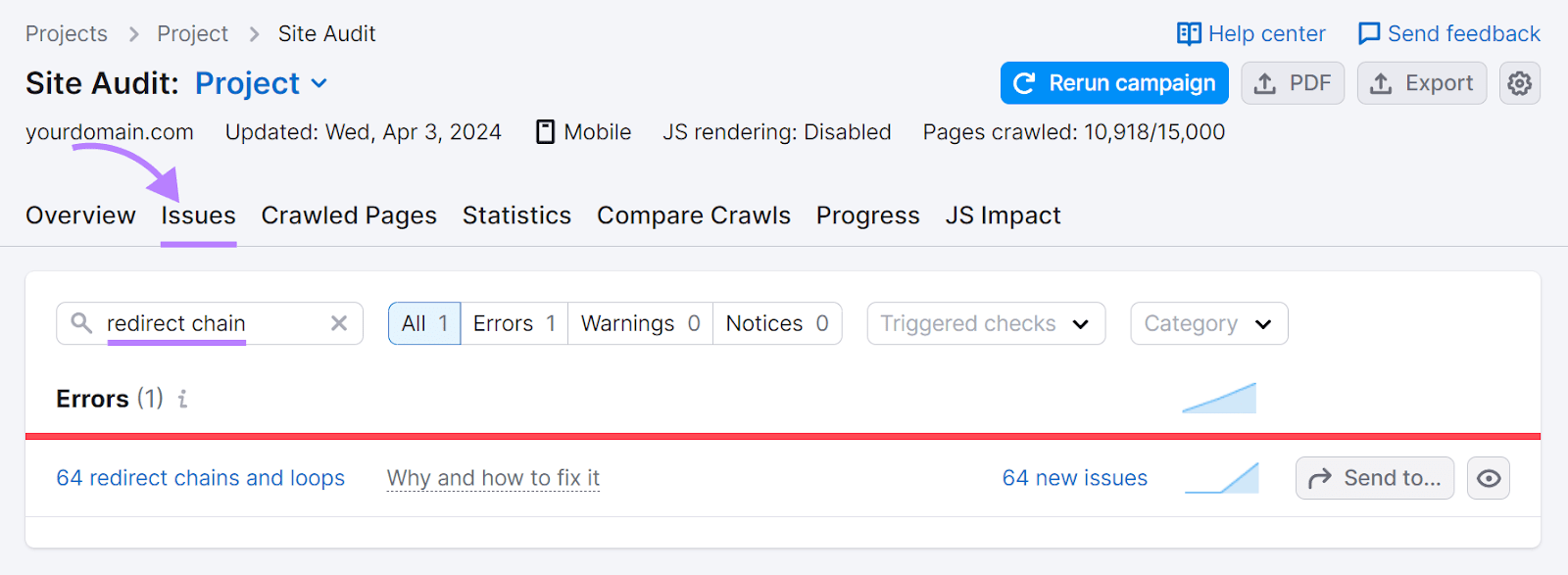
Click on on “# redirect chains and loops.”

You’ll then have the ability to see the affected pages.
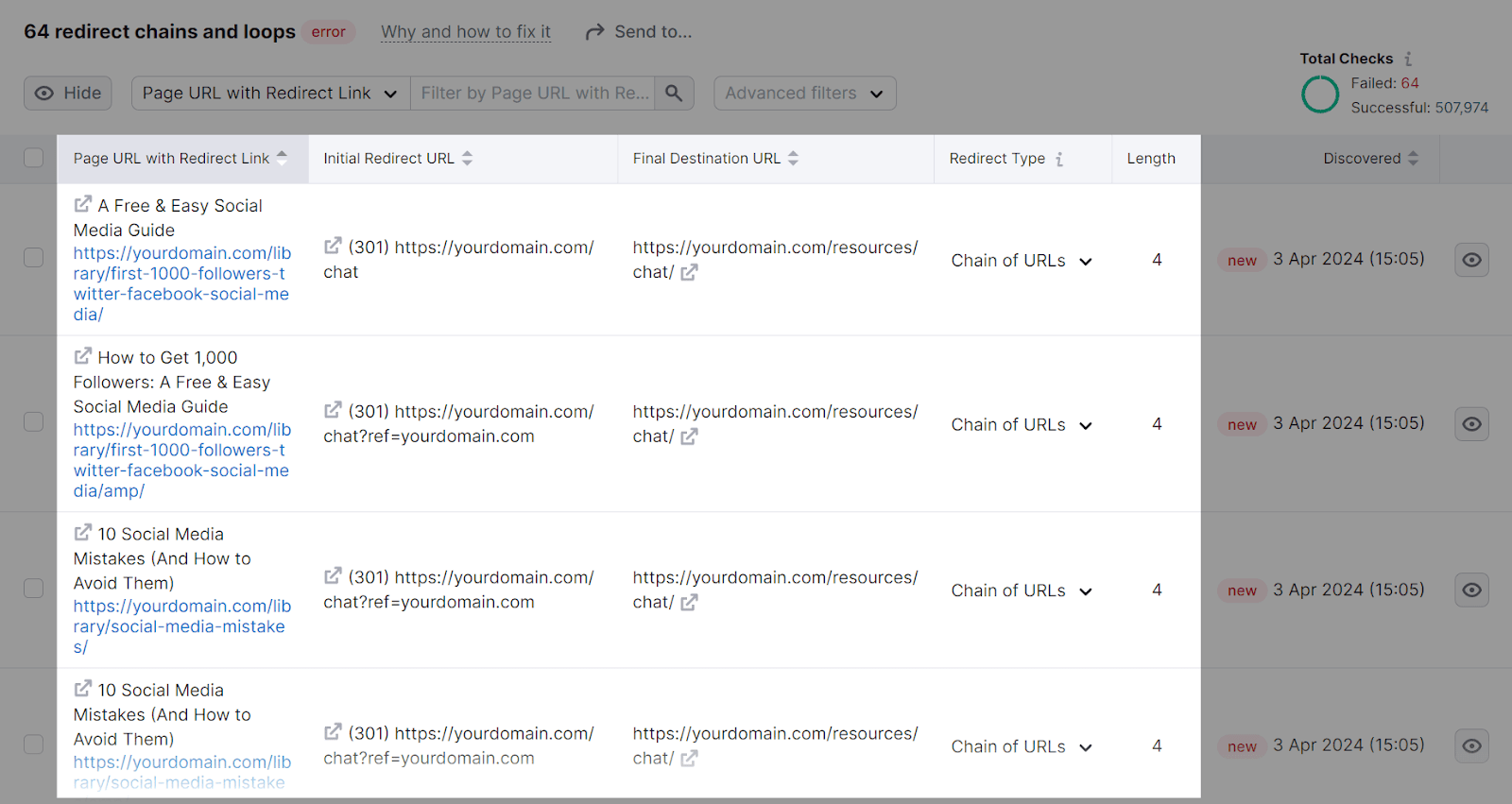
To repair chains, redirect every URL within the chain to your meant vacation spot web page.
To repair loops, you’ll want to alter one of many redirects to level to the right closing vacation spot. So it doesn’t return to the earlier URL.
3. Safe Your Web site with HTTPS
Hypertext switch protocol safe (HTTPS) encrypts the info exchanged between a customer’s browser and your web site. To maintain delicate data like login particulars and private data protected.
HTTPS is a ranking factor. So, securing your web site with HTTPS can enhance your search engine rankings. And it additionally builds belief along with your guests.
To change to HTTPS:
- Get a safe sockets layer/transport layer safety (SSL/TLS) certificates out of your internet hosting supplier (like Bluehost). Many hosts embody these certificates without cost or as an add-on.
- Activate the certificates by following your host’s or certificates supplier’s directions. They’re going to sometimes information you thru the method.
- Replace your web site’s settings to make use of HTTPS as a substitute of HTTP. Your host could have a easy choice for this. Or, you may want to switch your website’s configuration recordsdata to drive HTTPS connections.
- Arrange 301 redirects from HTTP to HTTPS in your total website. This tells search engines like google and yahoo and guests to make use of the safe model—even when they attempt to entry the non-secure one.
Consult with our information on How to Redirect HTTP to HTTPS (+ Best Practices) for step-by-step assist.
To examine whether or not there are any issues along with your HTTPS implementation, use Site Audit.
Click on “View particulars” within the “HTTPS” part.
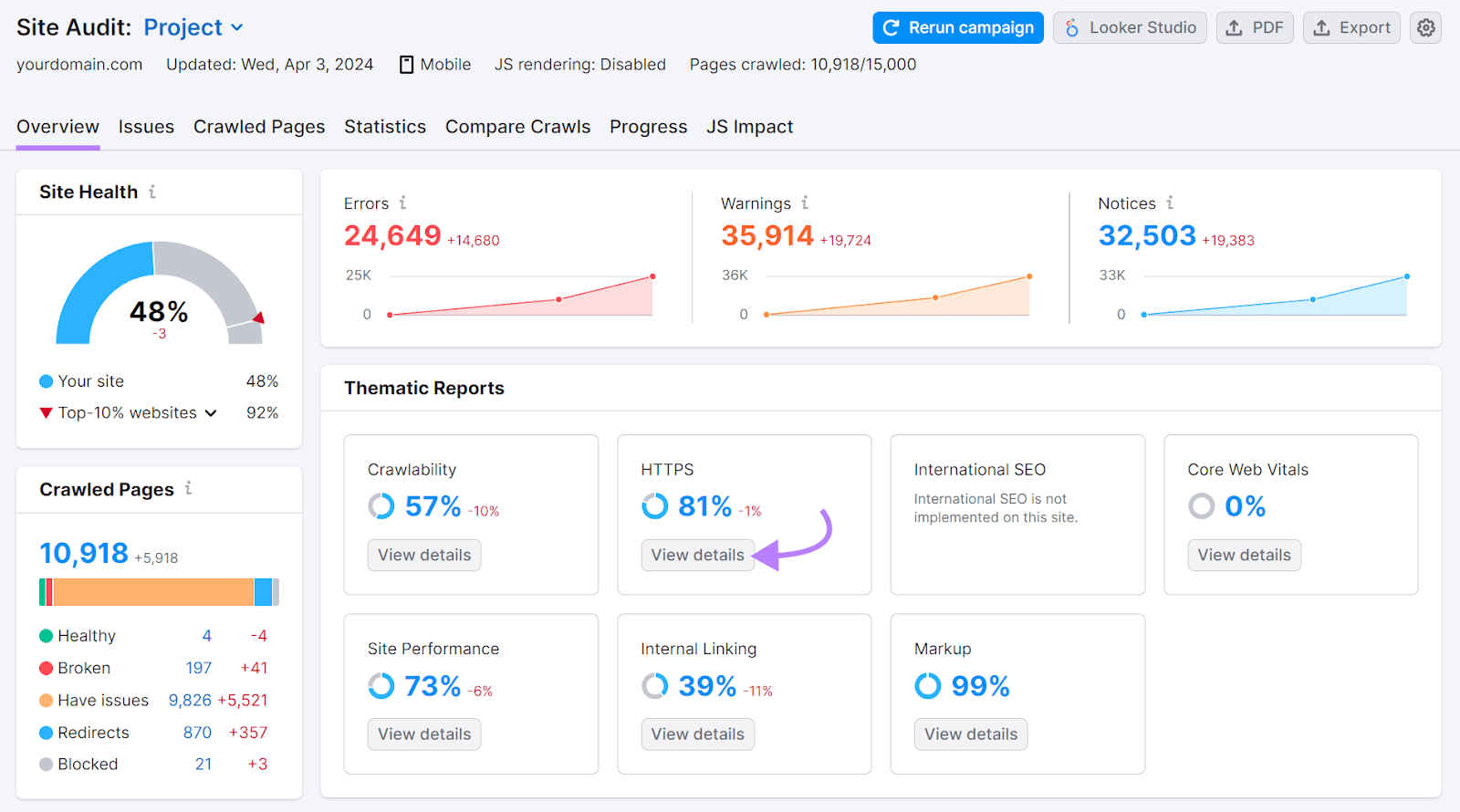
You’ll see an general rating and any points that should be addressed.
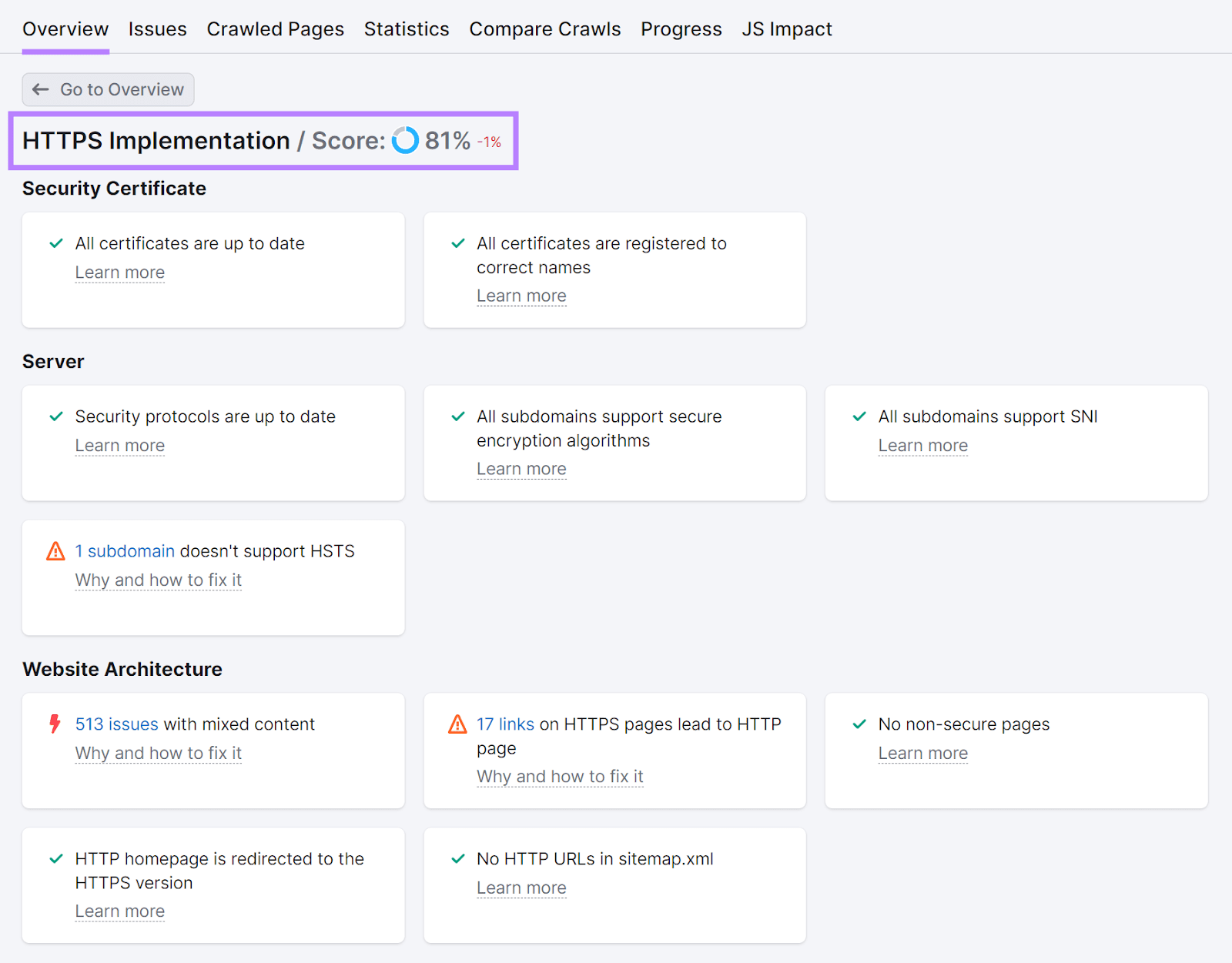
Click on “Why and find out how to repair it” subsequent to any downside that was flagged. To be taught extra about it and find out how to deal with it.
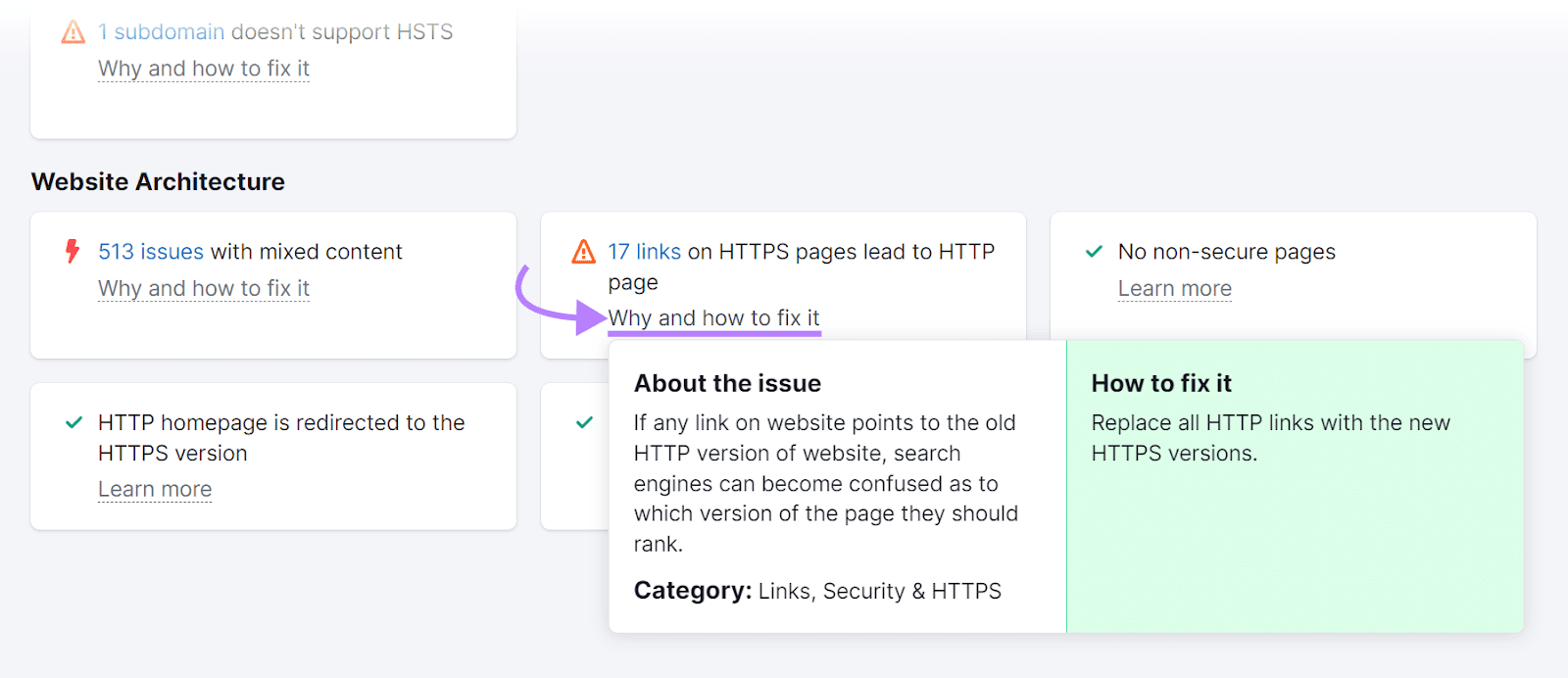
4. Make Your Web site Cellular-Pleasant
Your web site should carry out effectively on cellular gadgets to rank effectively in search outcomes. As a result of Google prioritizes the cellular variations of internet sites for indexing and serving pages to customers.
The most effective methods to make sure your website is mobile-friendly is by implementing a responsive design.
Responsive design makes use of HTML and CSS to mechanically alter your web site’s structure to suit the person’s display screen dimension. This makes your website straightforward to learn and navigate on any gadget.
If you happen to’re utilizing a web site builder or content material administration system (CMS), you are able to do this simply by selecting a responsive theme.
For instance, yow will discover many responsive WordPress themes on marketplaces like Themeforest.
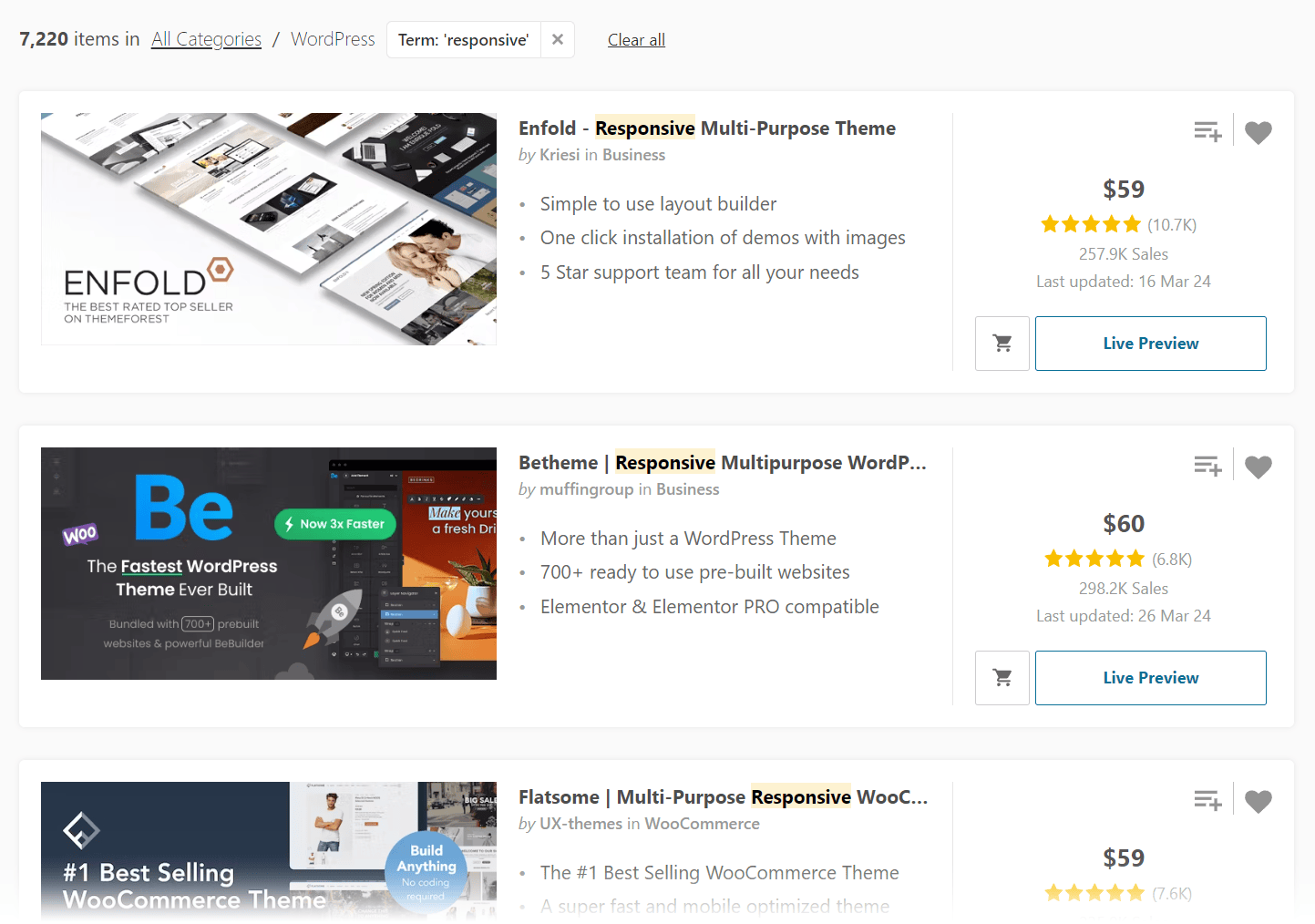
If you happen to’ve coded your web site your self or must make a non-responsive website responsive, use CSS media queries and versatile layouts.
These strategies let you alter for various display screen sizes. And mechanically resize or cover components as wanted.
Along with utilizing responsive design, prioritize the cellular expertise throughout the improvement stage by:
- Simplifying menus
- Growing button sizes
- Guaranteeing touch-friendly navigation
- Utilizing legible font sizes
- Incorporating white area
- Minimizing pop-ups
To assessment your website for any mobile-related points, use Site Audit.
Throughout setup, make sure the crawler is about to “SiteAuditBot-Cellular.” Which mimics the way in which Google crawls your website. And click on “Begin Web site Audit.”
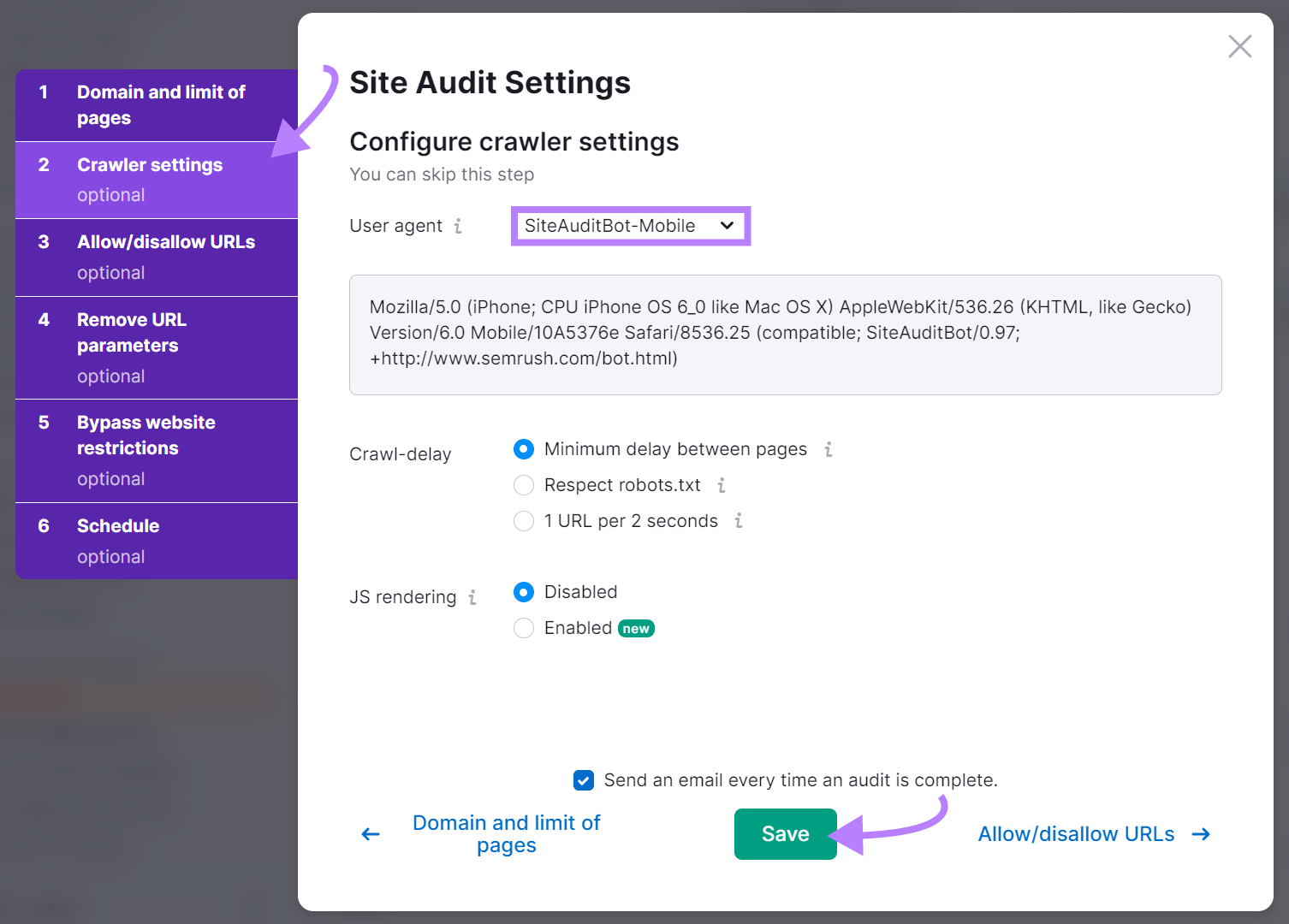
As soon as the audit is finished, go to the “Points” tab out of your report dashboard. And search “cellular” to deal with mobile-specific points.
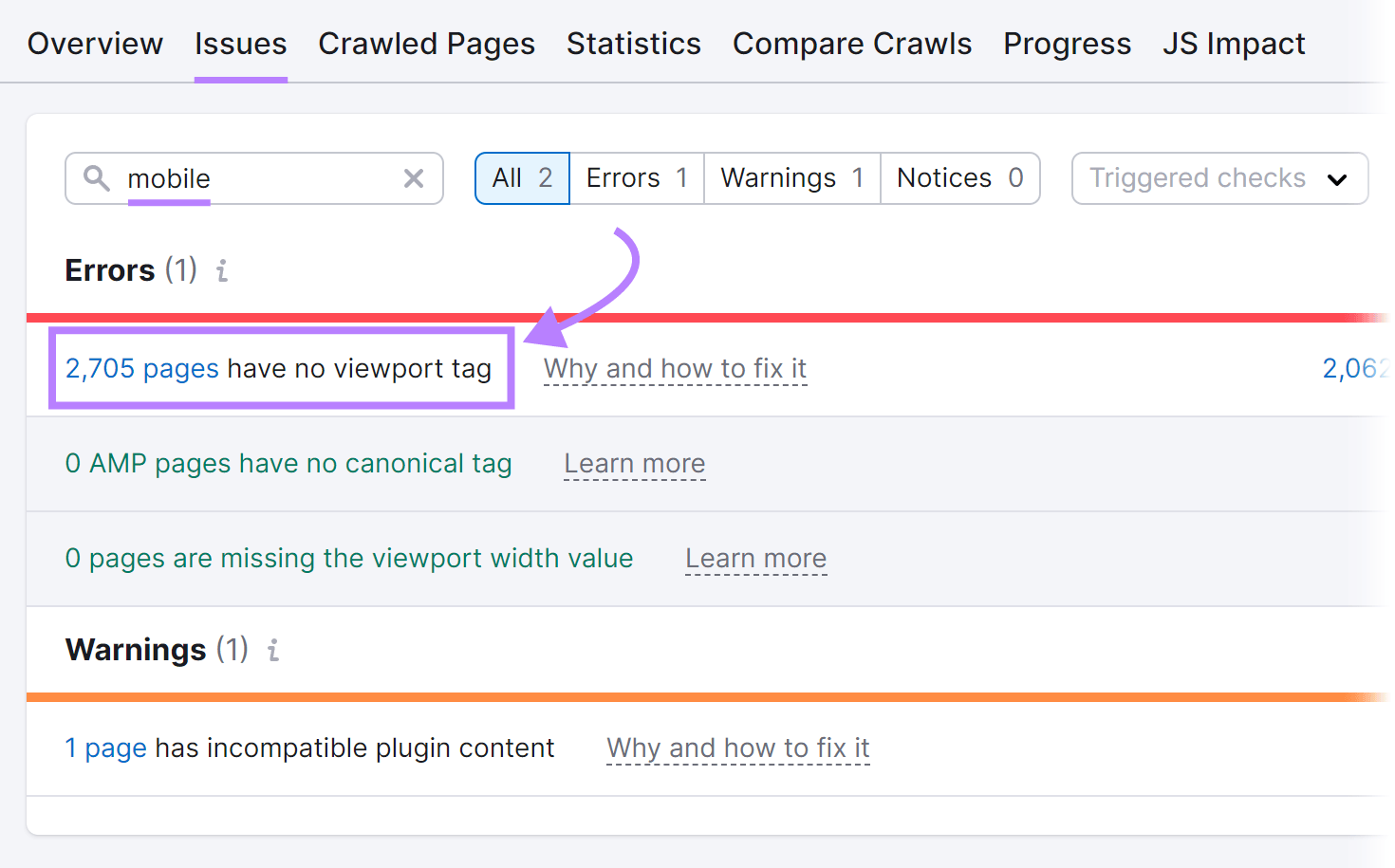
Tackle the problems and rerun the audit to make sure they’re resolved.
Additional studying: The Complete Guide to Mobile SEO: 8 Tips & Best Practices
5. Pace Up Your Web site
Guaranteeing your web site masses shortly has a direct affect in your search engine rankings. It additionally improves the person expertise.
So, take proactive steps to make your web site load as shortly as attainable. This is among the most vital search engine optimisation ideas for internet builders.
Use Google’s PageSpeed Insights to see how particular pages in your website are performing by way of pace on cellular and desktop.
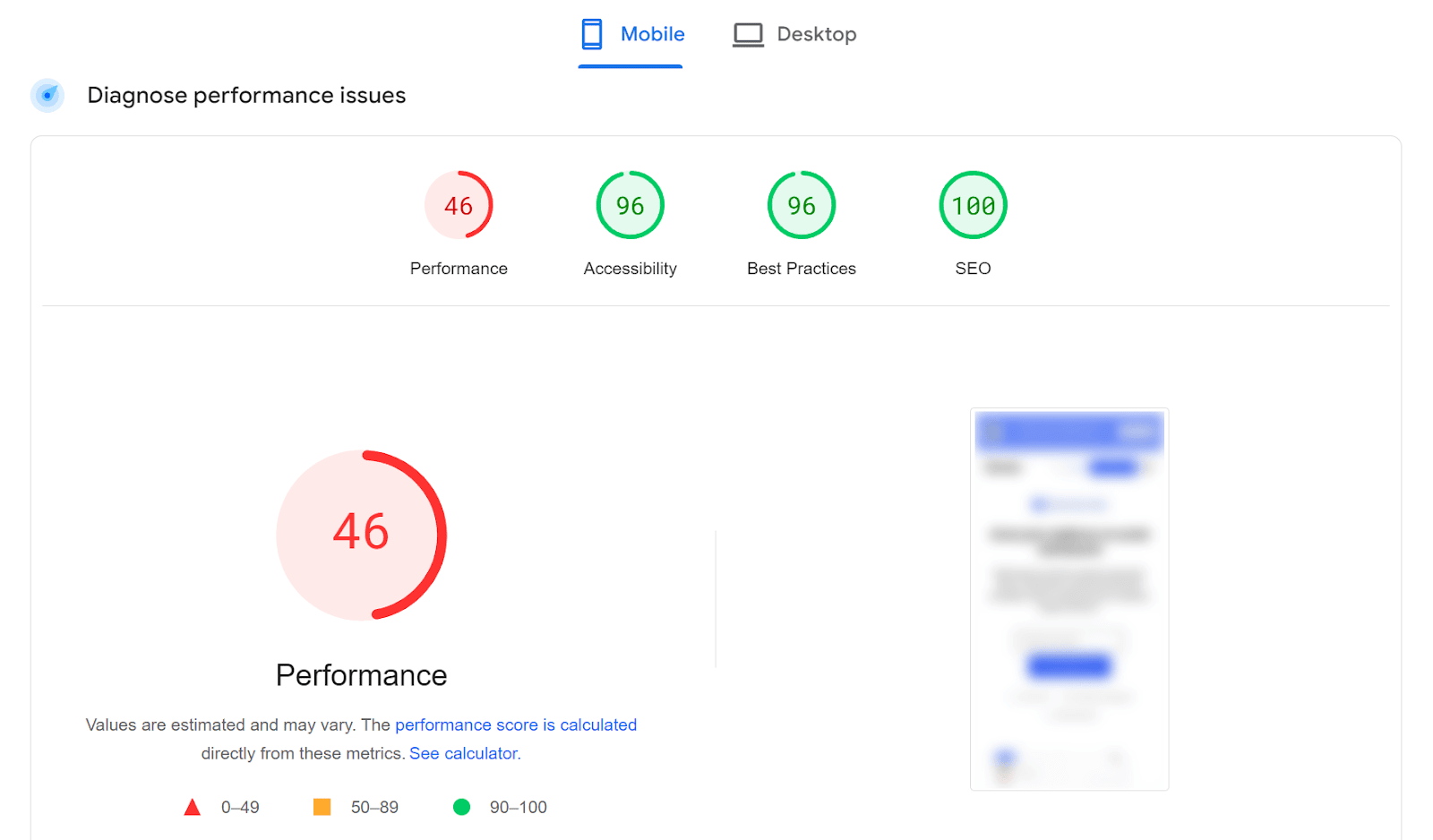
Scroll right down to examine the diagnostics. Primarily based on that, take steps to enhance your web page’s pace.
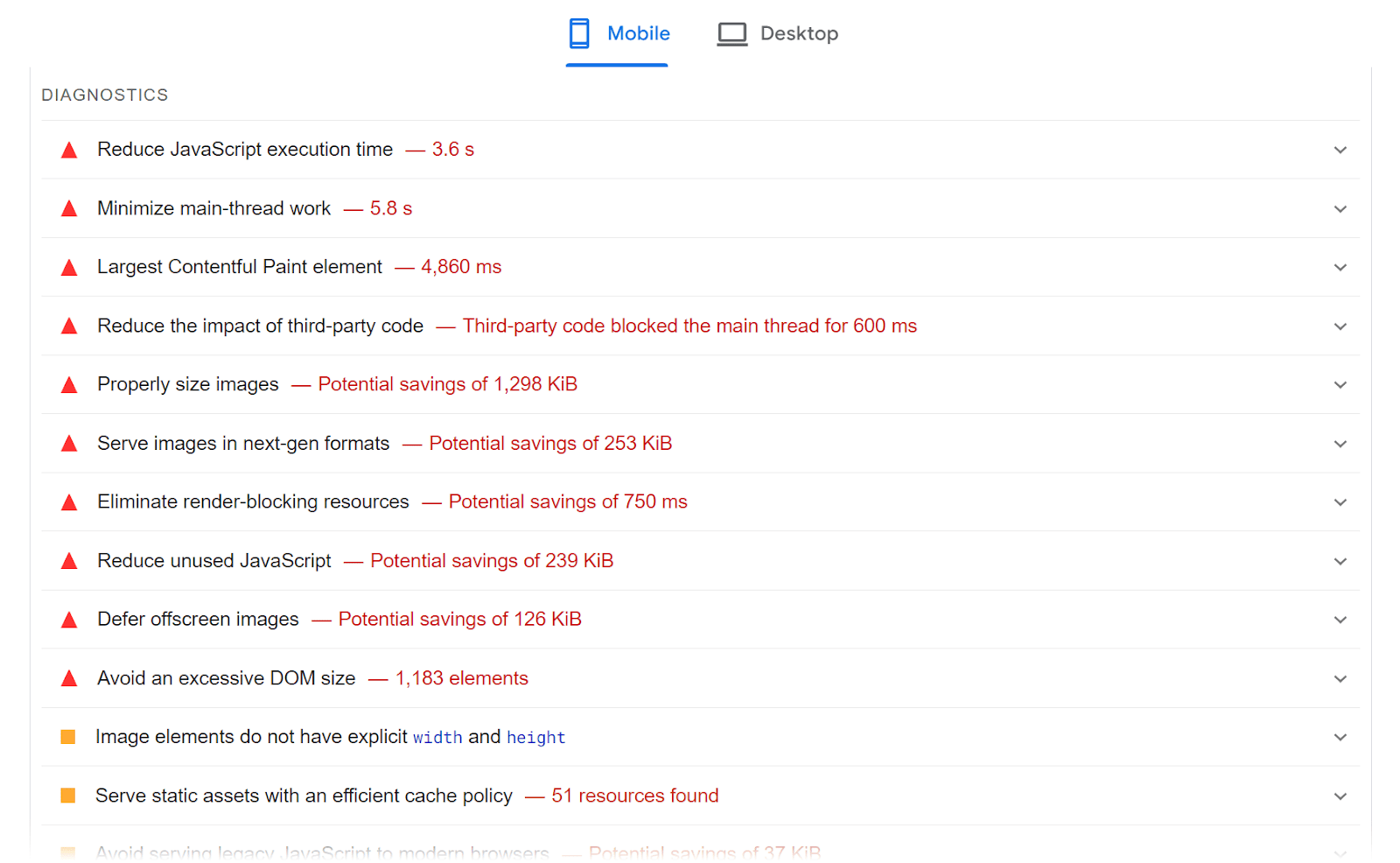
To guage pace throughout your total website, use Site Audit.
Go to your overview report. And click on “View particulars” within the “Web site Efficiency” part.
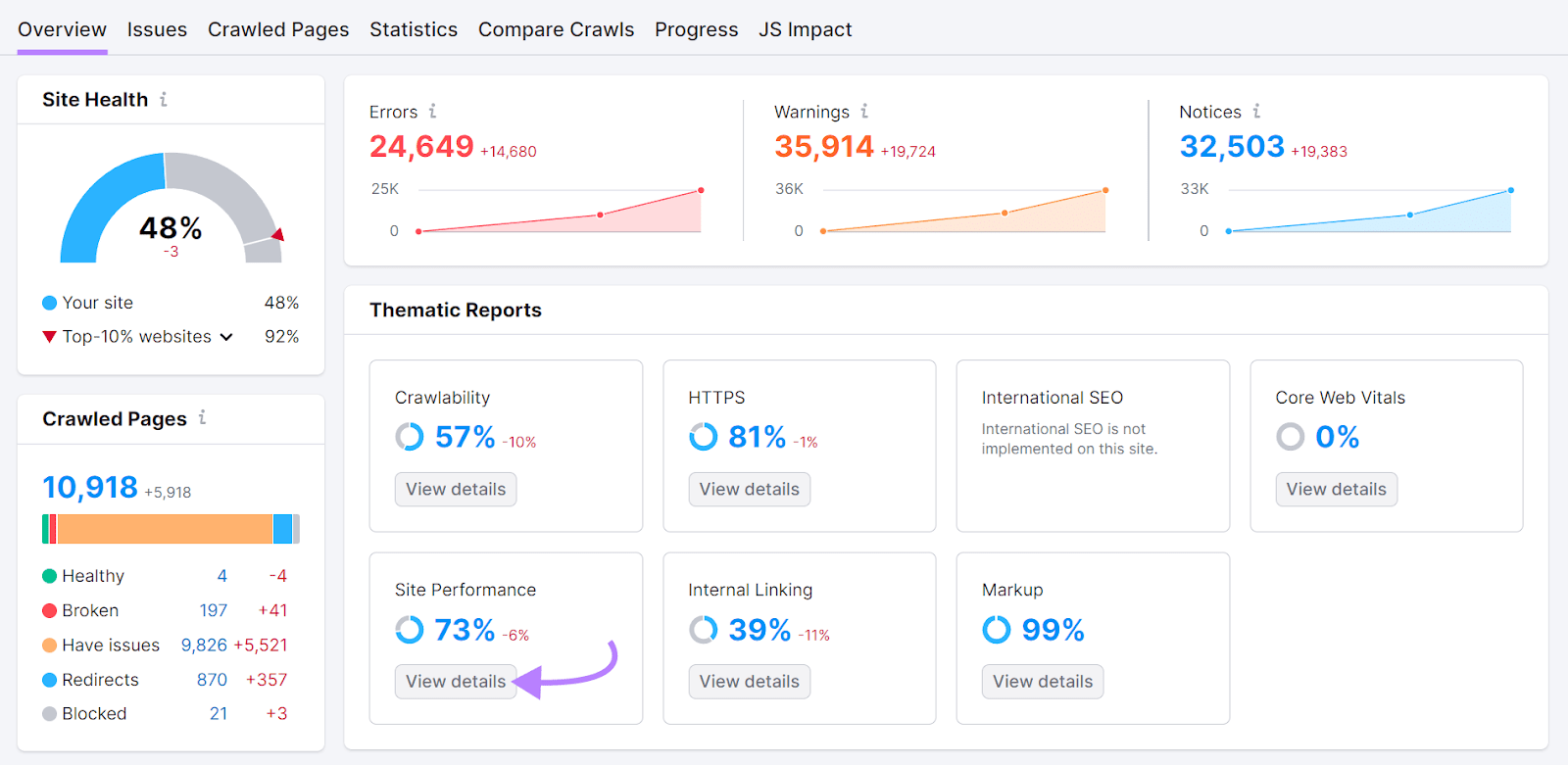
You may see an general rating. And points associated to your web site’s pace and efficiency.
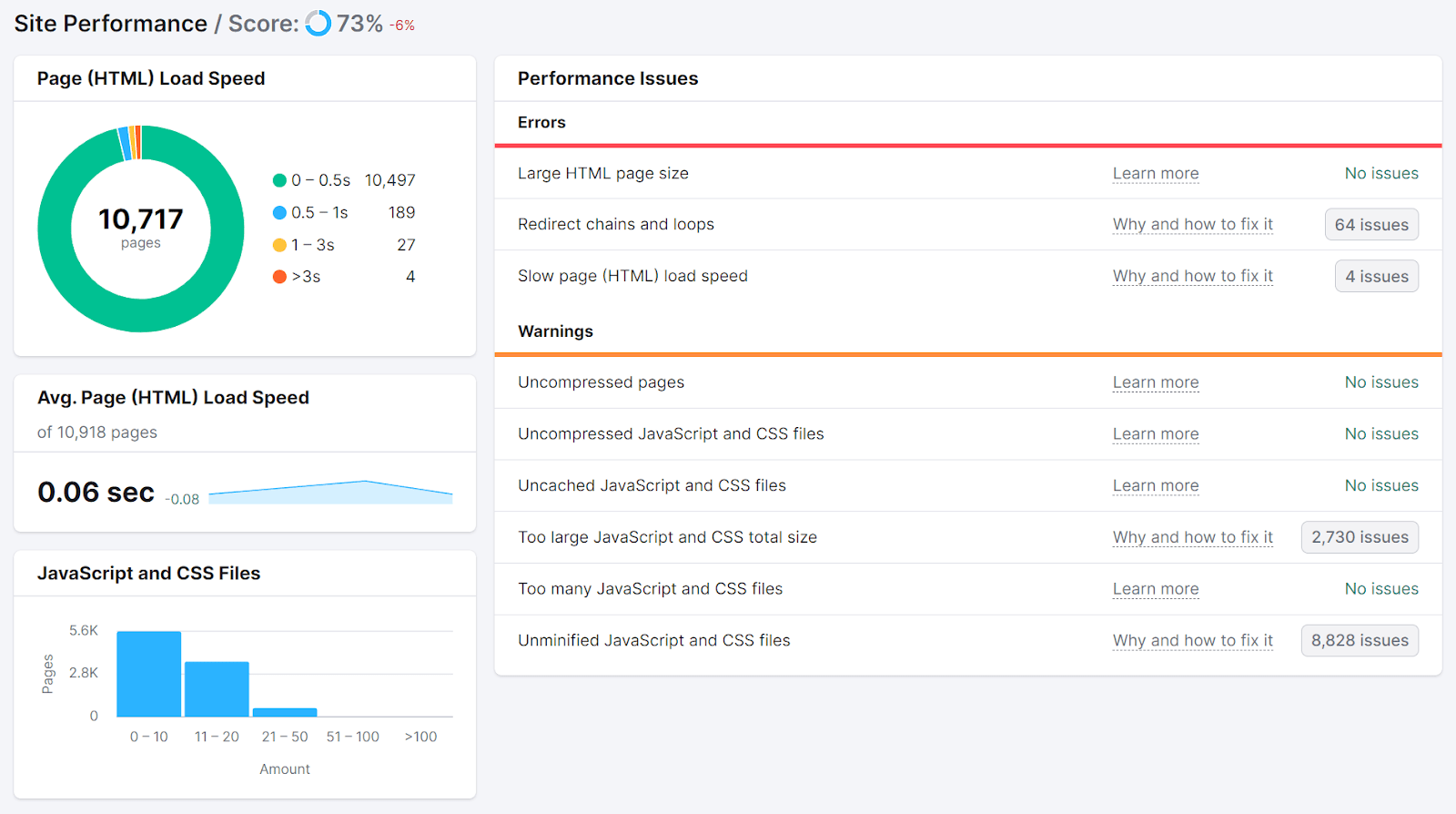
Sometimes, you’ll discover giant photographs slowing your website’s load pace.
So, ask your advertising staff to make use of free instruments like TinyPNG to scale back picture file sizes. And to decide on fashionable codecs like JPEG, PNG, and WebP.
And know that code with pointless characters, white areas, and redundant traces additionally slows down your website. So, minify your code utilizing Google’s recommended minification tools.
Additional studying: What Is Page Speed & How to Improve It
6. Implement Structured Information
Structured information (additionally referred to as schema markup) is code that gives extra data (e.g., product costs) to assist search engines like google and yahoo higher perceive your website’s content material. Which might improve your visibility in search outcomes and enhance natural site visitors.
How?
By making your content material eligible for wealthy snippets that show additional particulars straight in search outcomes. Like this:
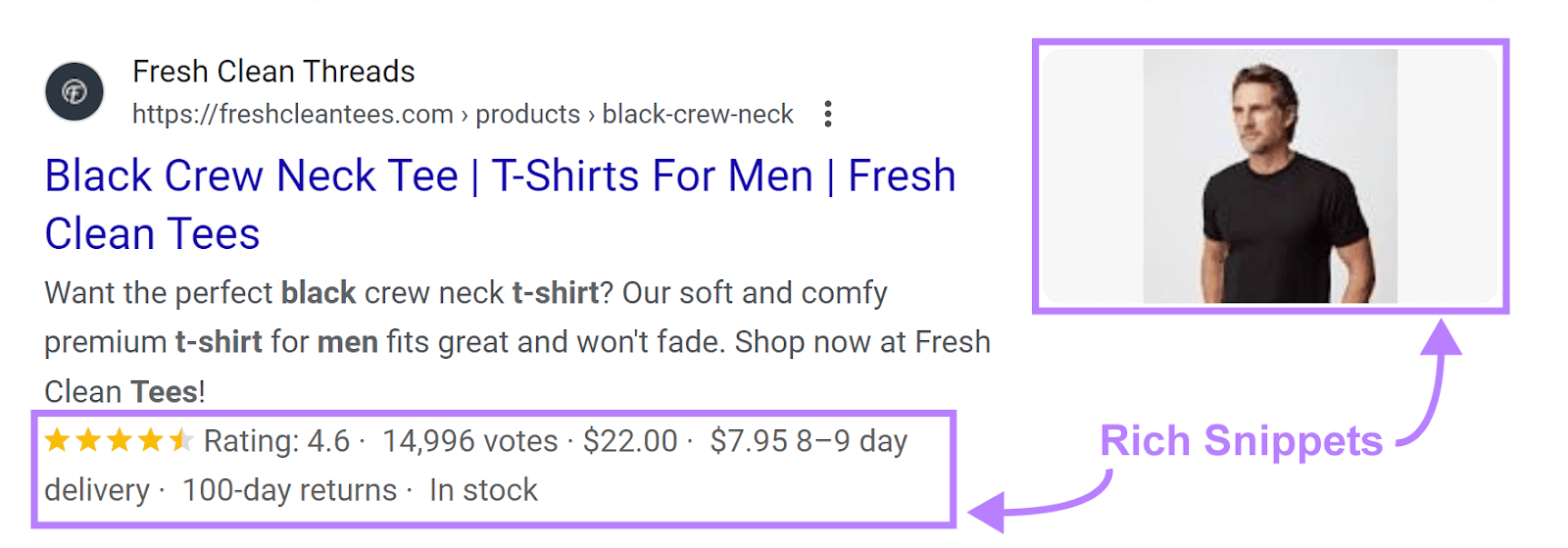
To implement structured information:
- Work along with your search engine optimisation or advertising staff to establish content material that would profit from structured information. Frequent kinds of schemas embody merchandise, articles, recipes, occasions, and opinions.
- Consult with Google’s documentation on structured information for builders to seek out the suitable schema in your content material sort
- Add the schema markup to your web site’s HTML code—JSON-LD is advisable
(For the whole course of, try our step-by-step information to implementing schema markup.)
As soon as you have added structured information to your web site, use the Site Audit instrument to see if there are any points with it.
Within the “Overview” tab, click on “View particulars” within the “Markup” part.
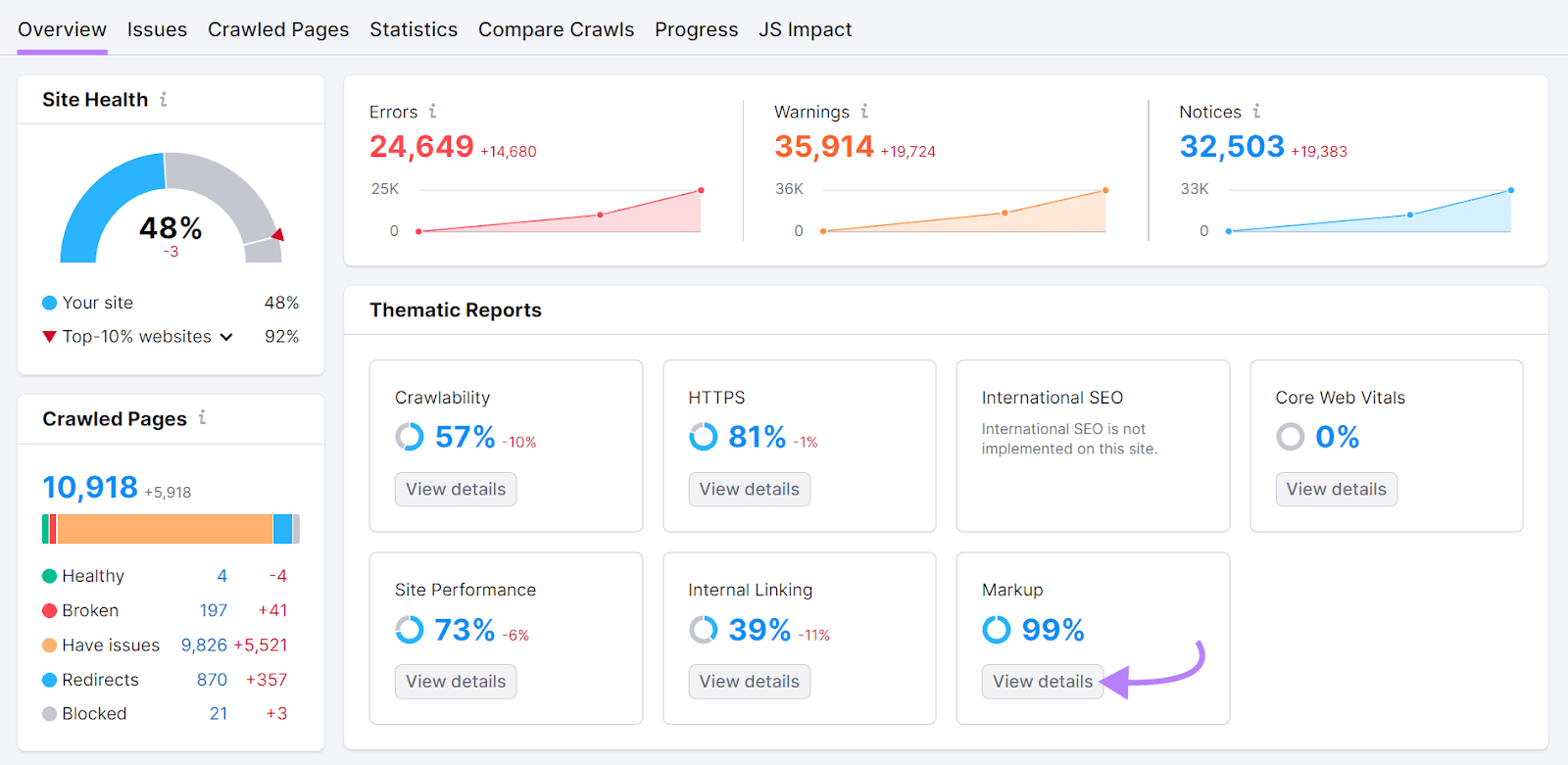
There’s a rating that signifies how a lot of your schema is legitimate in comparison with how a lot is invalid.
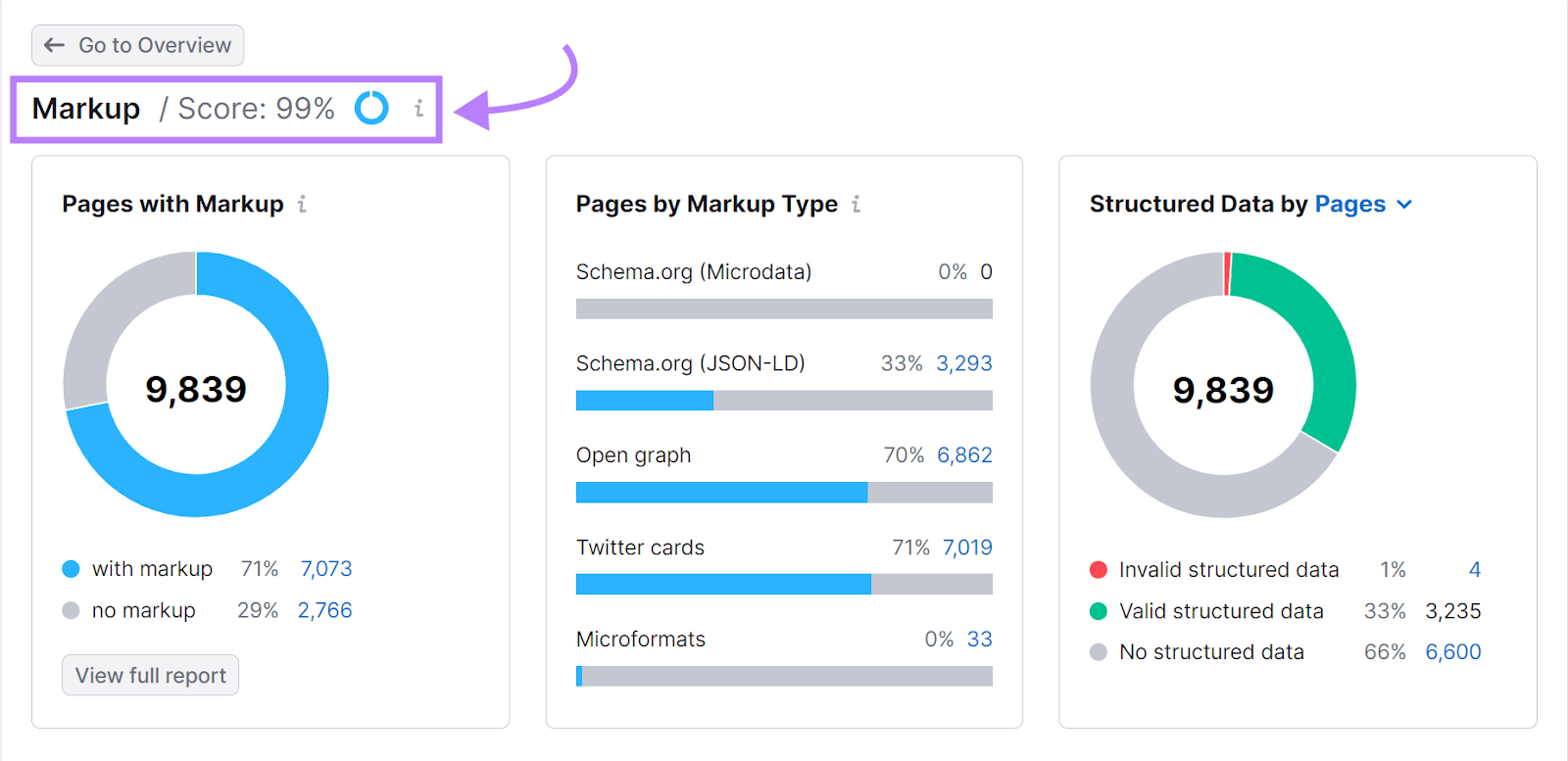
Scroll right down to the “Structured Information Gadgets” part. And click on “View all invalid gadgets” to see the total listing of errors.
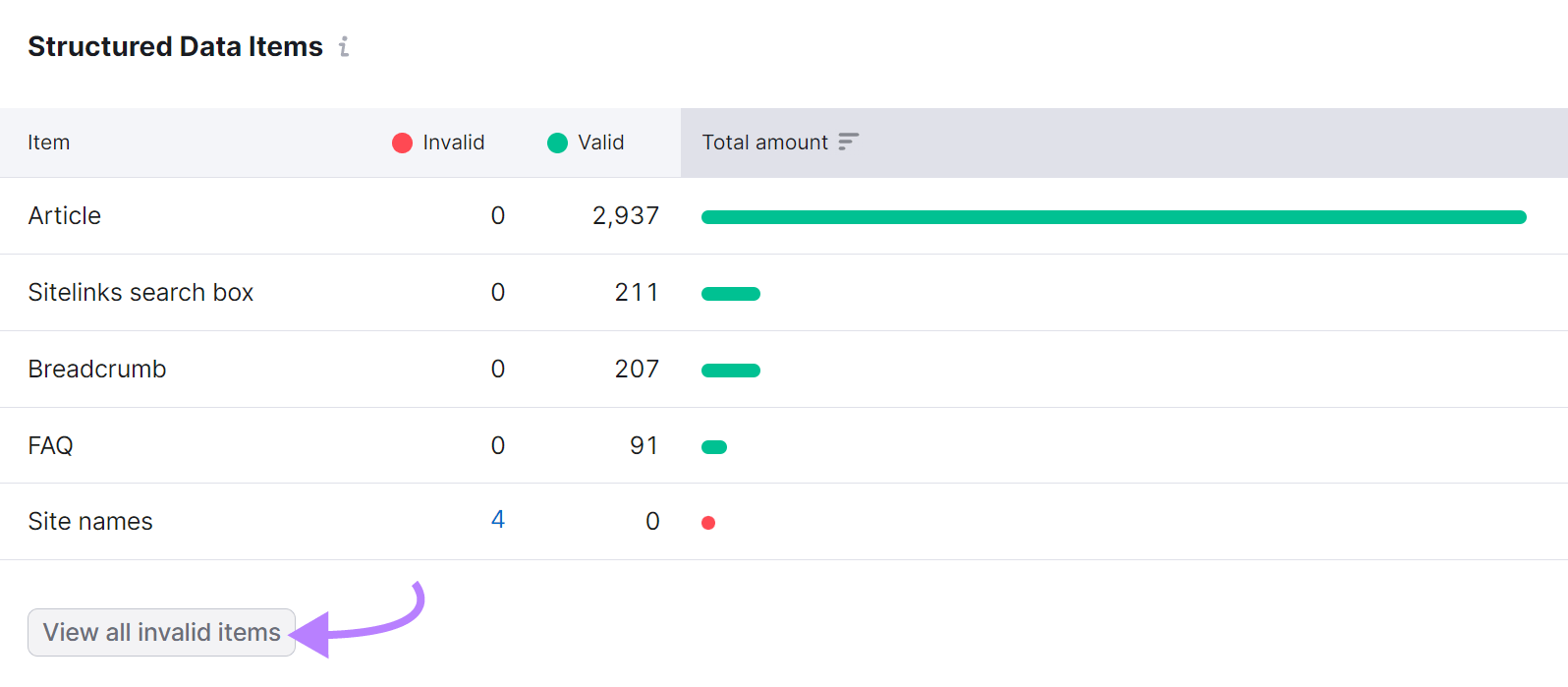
Modify your markup code as wanted to repair the issues.
7. Generate and Submit an XML Sitemap
An XML sitemap lists all of your vital pages to assist search engines like google and yahoo discover and (hopefully) index them.
Right here’s what the file seems to be like:
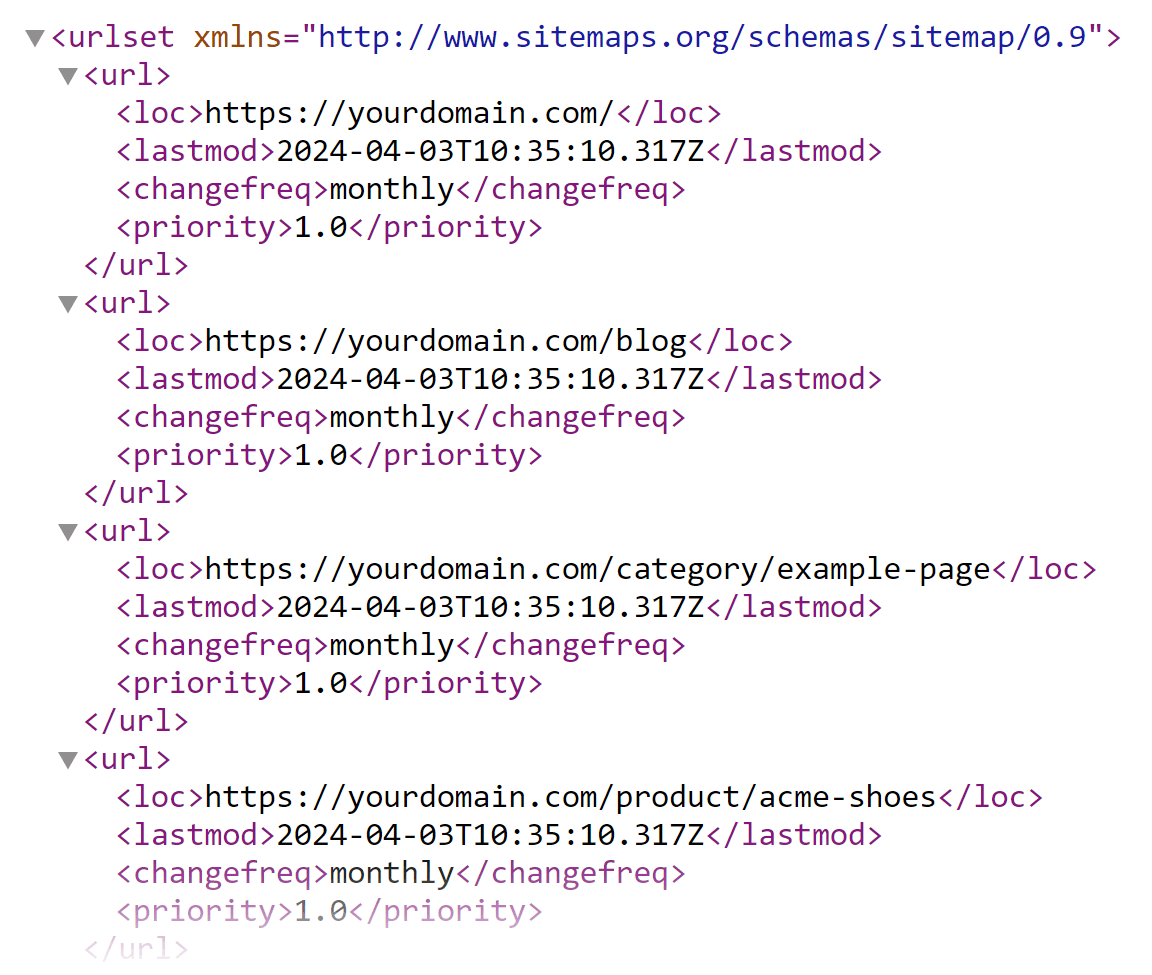
To create an XML sitemap, work along with your search engine optimisation or content material staff to establish a very powerful pages to incorporate in your sitemap.
Then, generate the sitemap utilizing your most popular technique. Reminiscent of coding it manually or utilizing a plugin or on-line generator.
Some platforms (like WordPress, Shopify, and Wix) generate XML sitemaps mechanically. In that case, you simply must retrieve it.
If you happen to’ve created your individual sitemap, add it to your web site’s server.
Sometimes, you will place it in your web site’s root listing. So, in case your web site is “www.instance.com,” you’ll place your sitemap at “www.instance.com/sitemap.xml.”
After importing your sitemap, run the Site Audit instrument to examine if it is formatted appropriately.
Go to the “Points” tab and search “sitemap” to see if there are any points associated to your sitemap.xml file.

Tackle any points the instrument flags.
When you’ve ensured your sitemap is error-free, submit it to Google through Google Search Console (GSC).
Log in to your GSC account and navigate to “Indexing” > “Sitemaps.”
Paste your sitemap URL within the area offered and click on “Submit.”
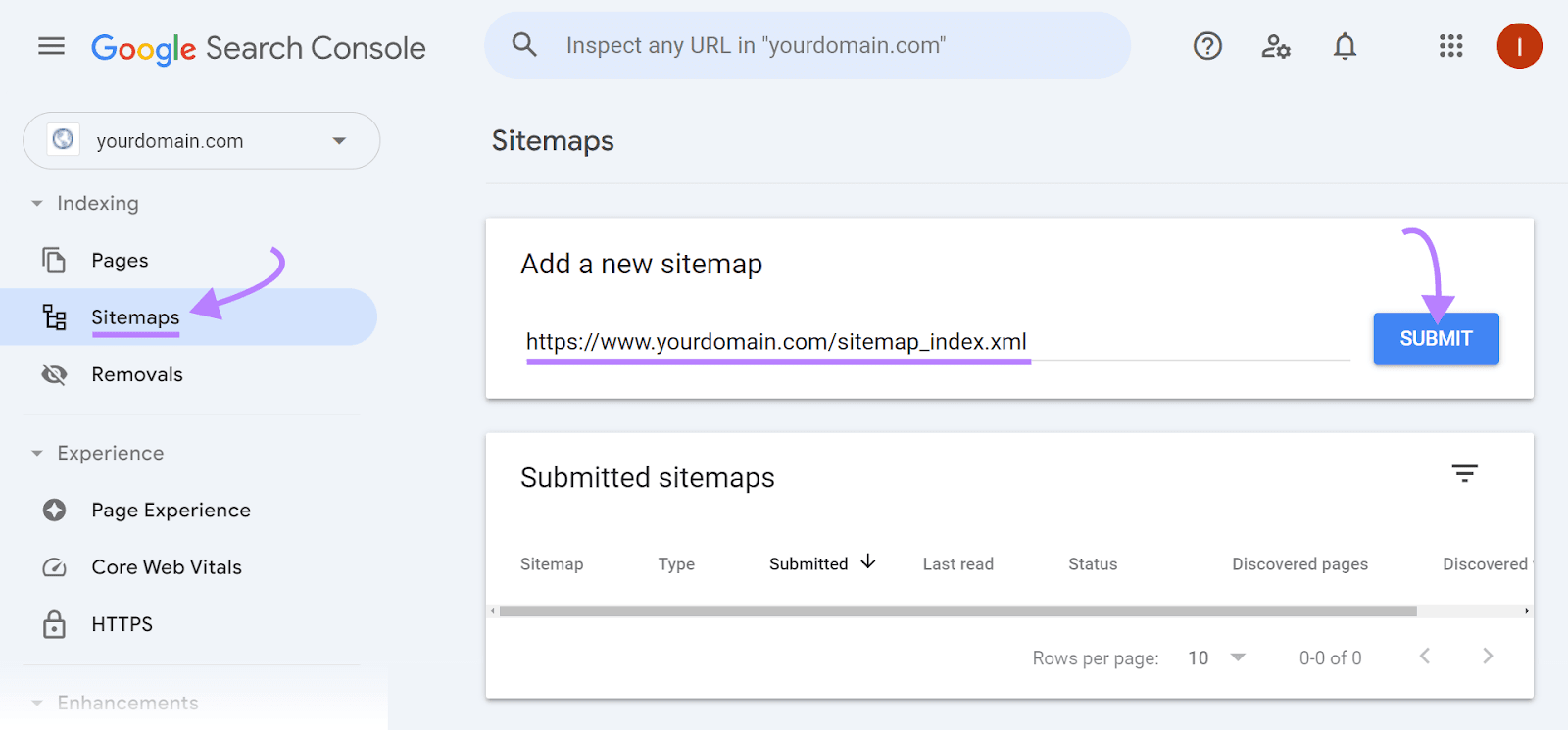
If you happen to use a CMS that creates this file by itself, your sitemap will mechanically get up to date each time you add new content material to your website or replace previous pages.
However in case you manually preserve your sitemap or use a customized setup that does not mechanically replace it, keep in mind to refresh it if you add new pages or replace present content material.
8. Implement Canonical Tags
Canonical tags point out which model of a web page is the first one when it has a number of variations. To make sure search engines like google and yahoo know which model you’d choose to indicate in search outcomes.
With out them, search engines like google and yahoo have bother understanding which web page to deal with. And will not present any of your pages in search outcomes.
Canonical tags are added within the <head> part of a webpage. Like this:
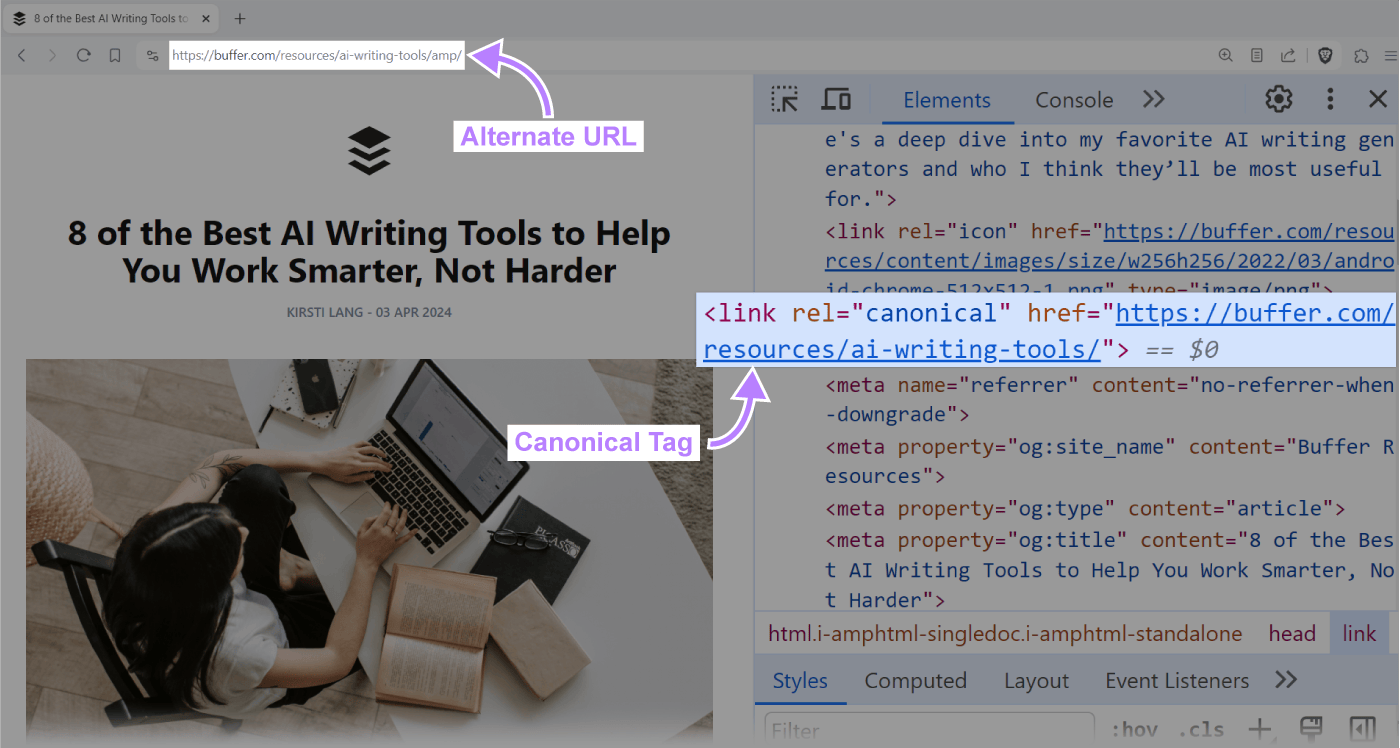
Work along with your search engine optimisation or advertising staff to establish pages that want canonical tags.
They will use Site Audit to seek out duplicate content material points throughout your web site. By going to the “Points” tab and looking “duplicate content material.”
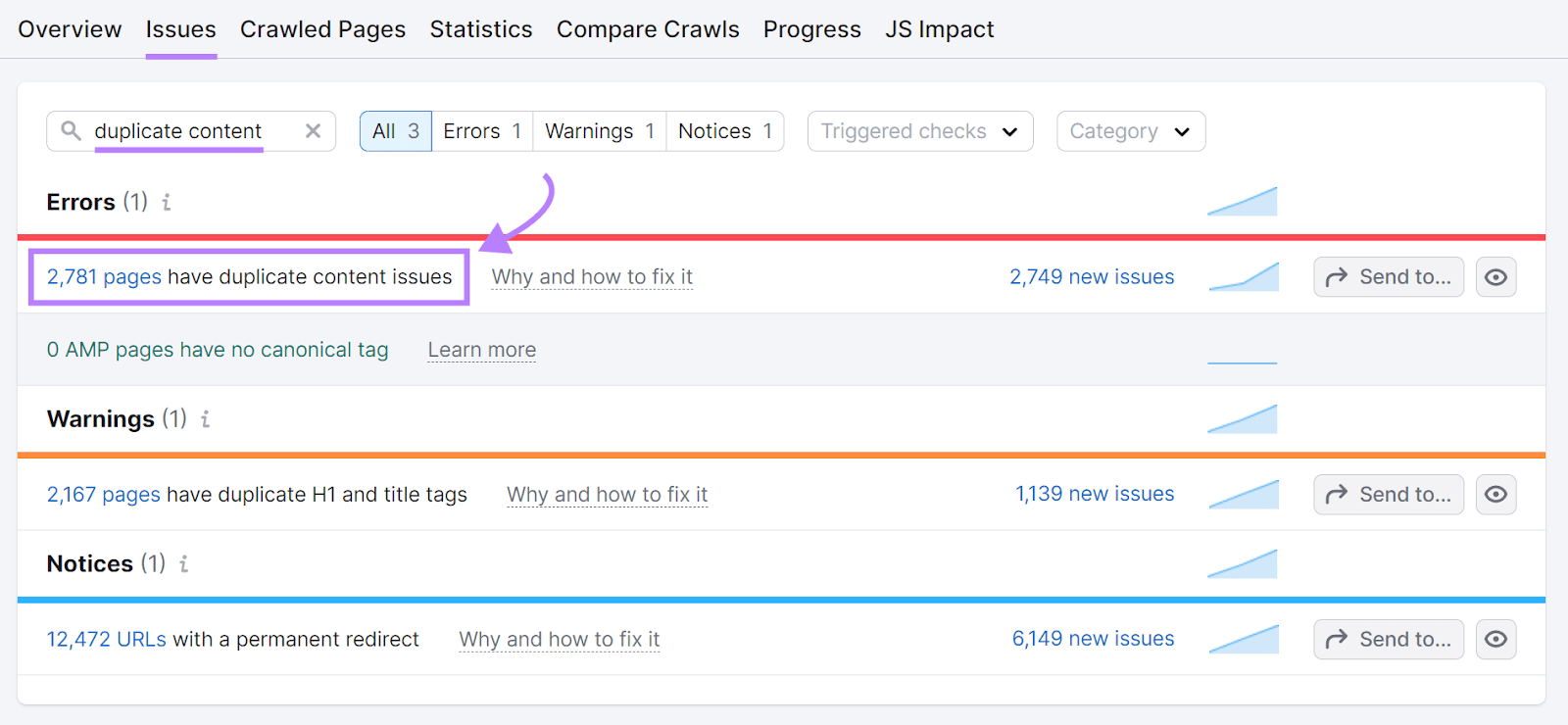
As soon as they’ve recognized the principle web page for every group of duplicates, you possibly can implement canonical tags.
Simply add the next line within the <head> part of the duplicate pages:
<hyperlink rel="canonical" href="http://www.yourwebsite.com/main-product-page">
9. Configure Your Robots.txt File Appropriately
A robots.txt file tells search engine crawlers which components of your web site to entry and which to disregard. Which helps cover pages you don’t wish to be listed and ensures extra of your vital pages could be discovered.
Right here’s an instance of a robots.txt file:
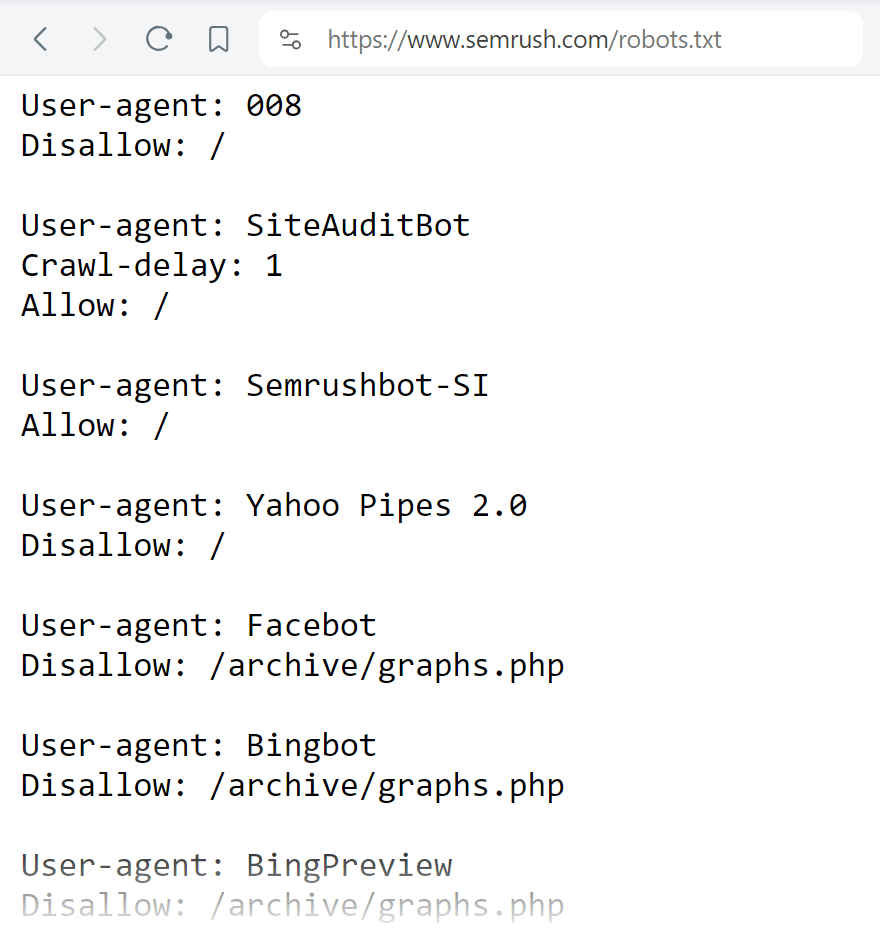
In your robots.txt file, you should utilize the “disallow” directive to dam search engines like google and yahoo from indexing particular pages, directories, or total sections of your website.
The instance under exhibits find out how to block the complete “personal” listing and a particular web page:
Disallow: /personal/
Disallow: /web page.html
You can too use the “permit” directive to make exceptions for particular pages or directories inside a blocked part.
Right here’s how you’ll block search engines like google and yahoo from the complete “personal” listing however permit a particular web page inside that listing:
Consumer-agent: *
Disallow: /personal/
Enable: /personal/public-page.html
And you’ll specify search engine bots utilizing the “user-agent” directive.
For instance, that is how you’ll block Google from crawling your total website:
Consumer-agent: Googlebot
Disallow: /
To make your individual, begin by making a file utilizing a textual content editor (like Notepad). And embody all the suitable directives (you might have to work along with your advertising and search engine optimisation groups for this).
If you’re finished, add this robots.txt file to the basis listing of your web site.
Lastly, guarantee your robots.txt file has no points.
Run a Site Audit and go to the “Points” tab. And search “robots.txt.”
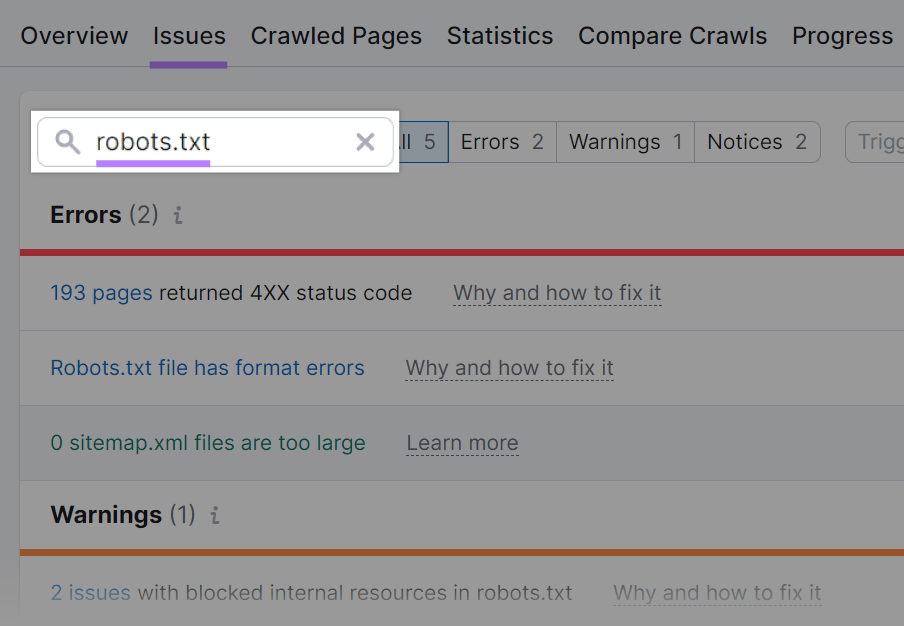
If there are format errors, click on “Robots.txt file has format errors” to see a listing of invalid traces that should be fastened.
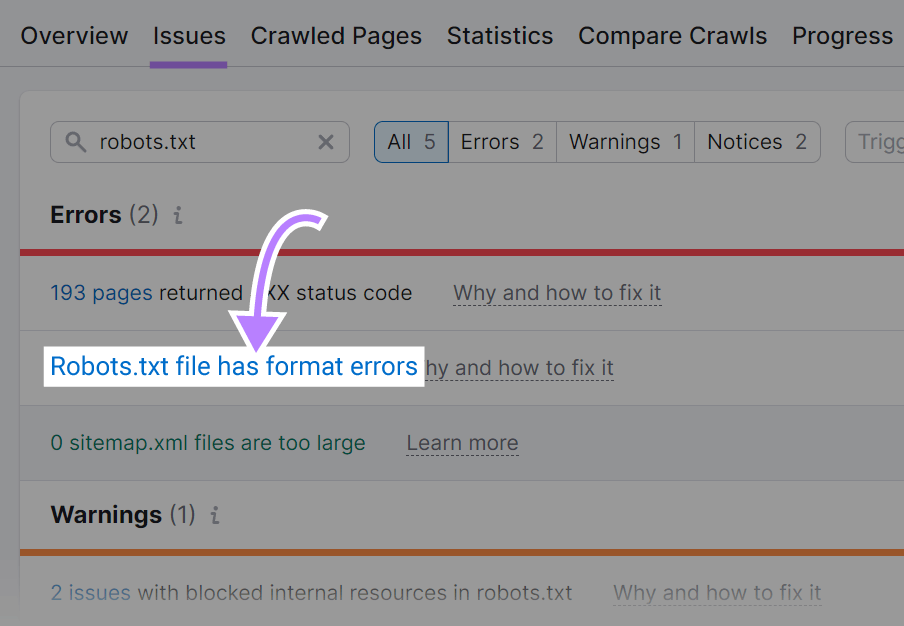
10. Make Your Web site Accessible
Guaranteeing your web site is accessible to everybody—together with customers with disabilities—creates an inclusive atmosphere and broadens your viewers attain. This boosts your website’s UX, which not directly impacts search engine optimisation.
The most effective methods to prioritize accessibility is to make use of semantic HTML. Which conveys the which means and construction of your content material to assist customers with visible impairments who depend on display screen readers and search engines like google and yahoo to know what’s on the web page.
There are two most important kinds of HTML tags:
- Construction tags: These outline the general construction of the web page (e.g., <header> for introductory web page data and <nav> for navigation hyperlinks)
- Textual content formatting tags: These point out the kind of textual content (e.g., <p> for paragraphs and <a> for hyperlinks)
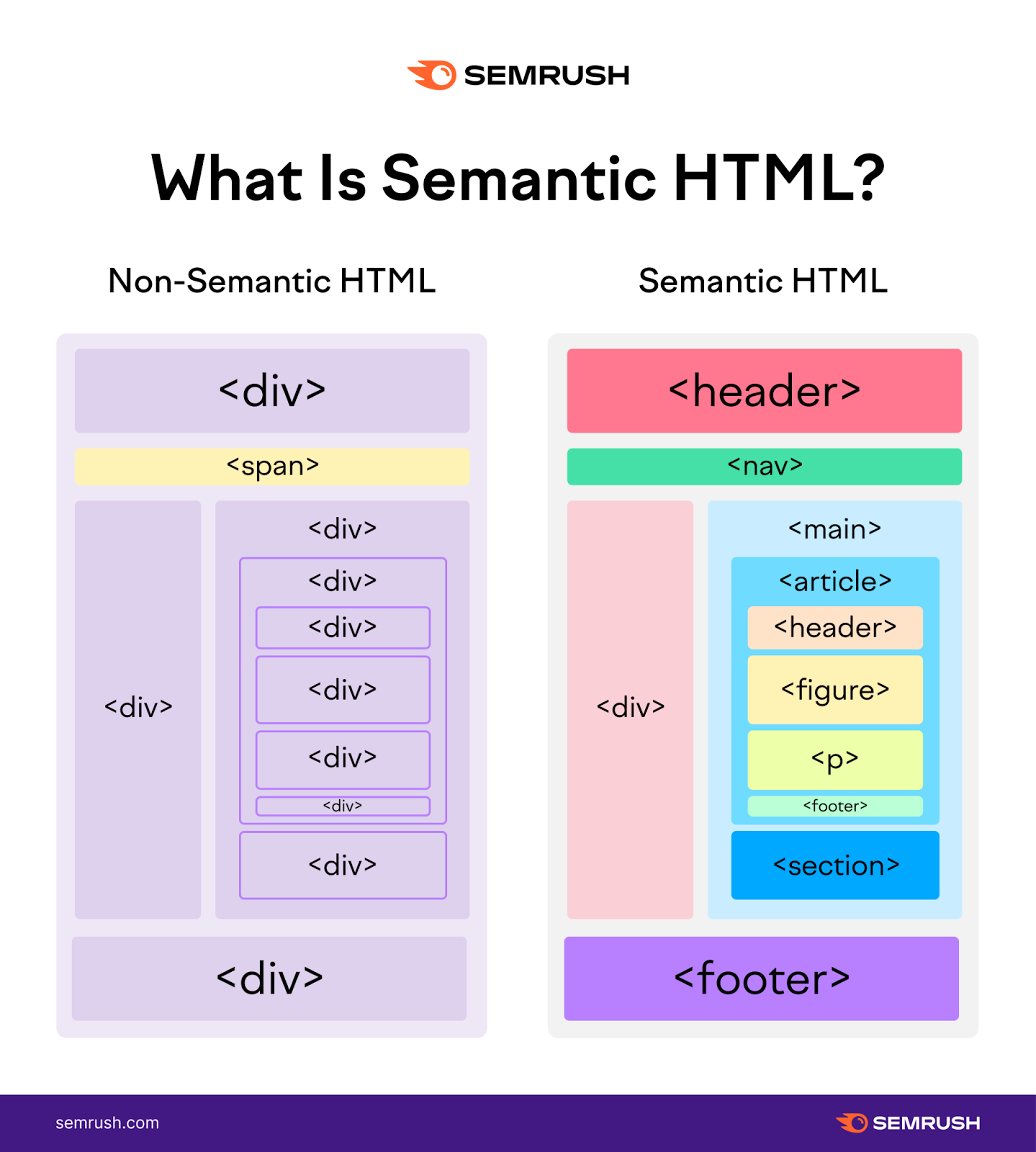
To make sure the remainder of your staff makes use of these tag sorts appropriately, create replicable templates that embody semantic HTML tags.
And know that many CMSs used for creating weblog posts present user-friendly editors that permit content material creators to use these components with out writing code straight.
You possibly can additional improve accessibility by making your website keyboard-navigable. So, guarantee all interactive components (like hyperlinks, buttons, and kind controls) are reachable and operable with a keyboard.
And intention for enough distinction between textual content and background colours to enhance readability for customers with visible impairments.
Use Semrush’s Accessibility Scan & Monitor app to examine your website’s accessibility compliance.
Open the instrument, enter your area, and click on “Begin Scan.”
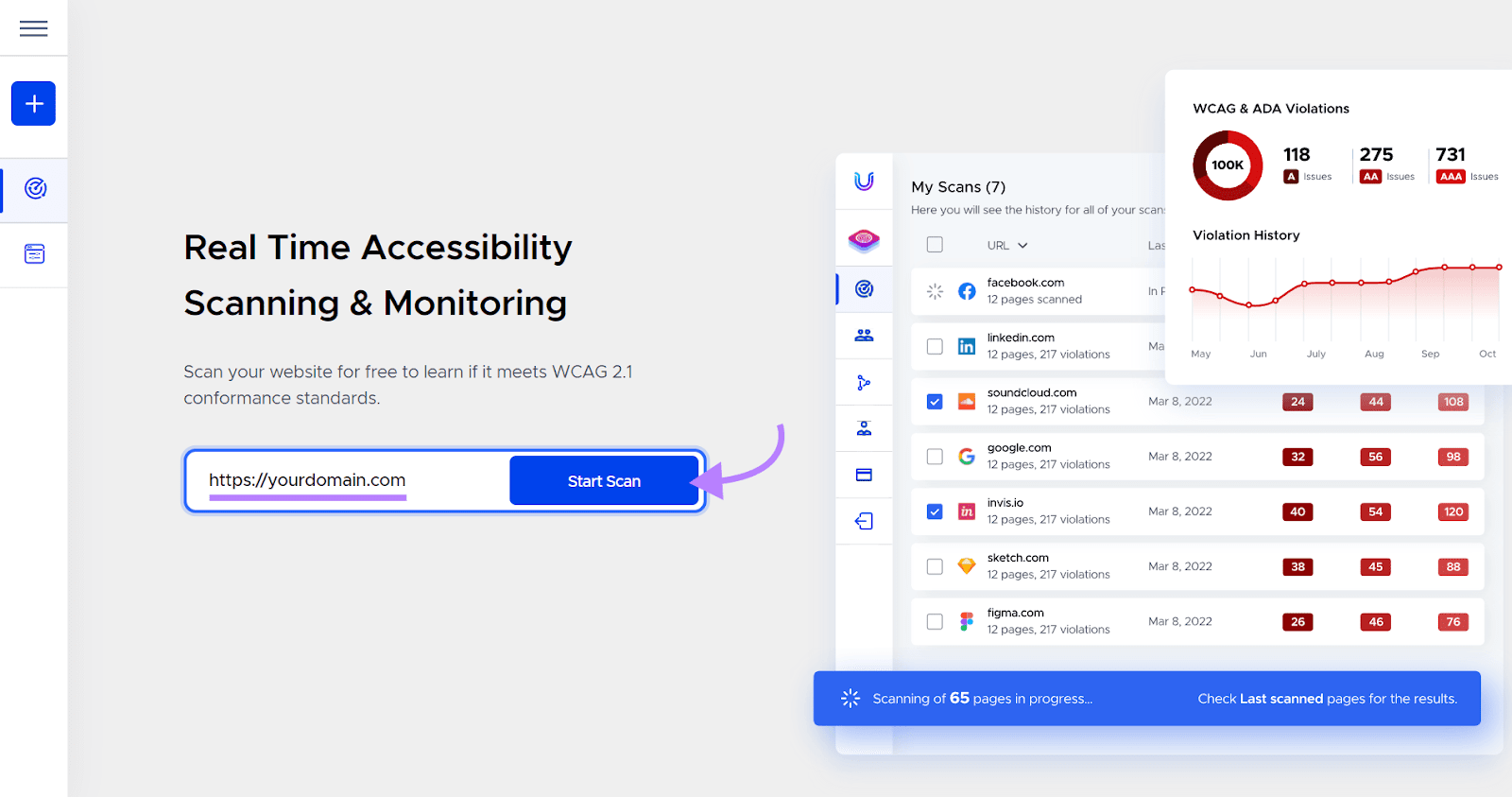
Choose the URLs you wish to consider from the listing and click on “Scan # pages.”
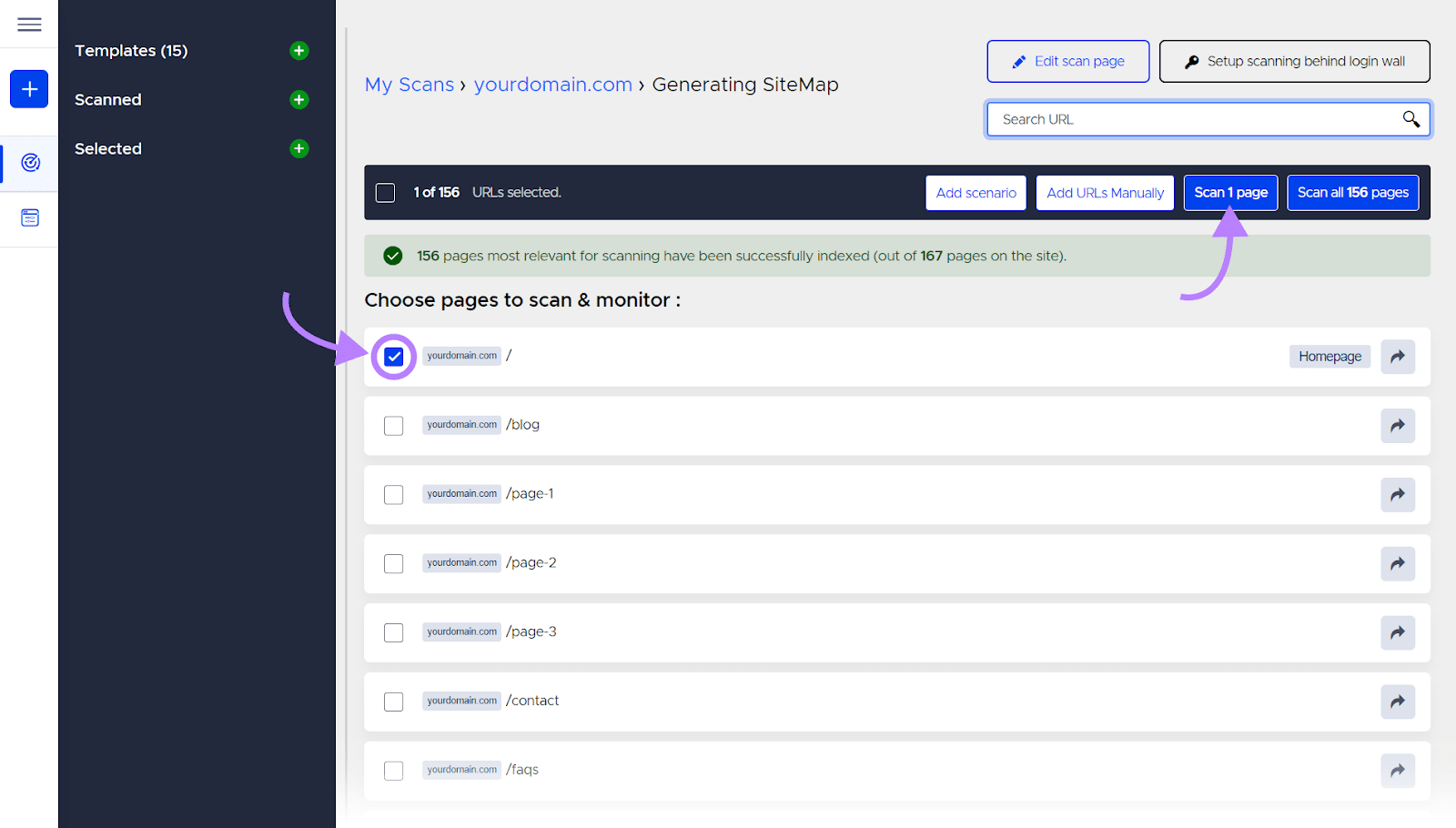
The instrument makes use of AI to scan your website for points (on desktop and cellular). And helps you establish web site components and contours of code resulting in violations.
Click on the “Dashboard” button to be taken to a report scoring your accessibility compliance and itemizing all of the violations.
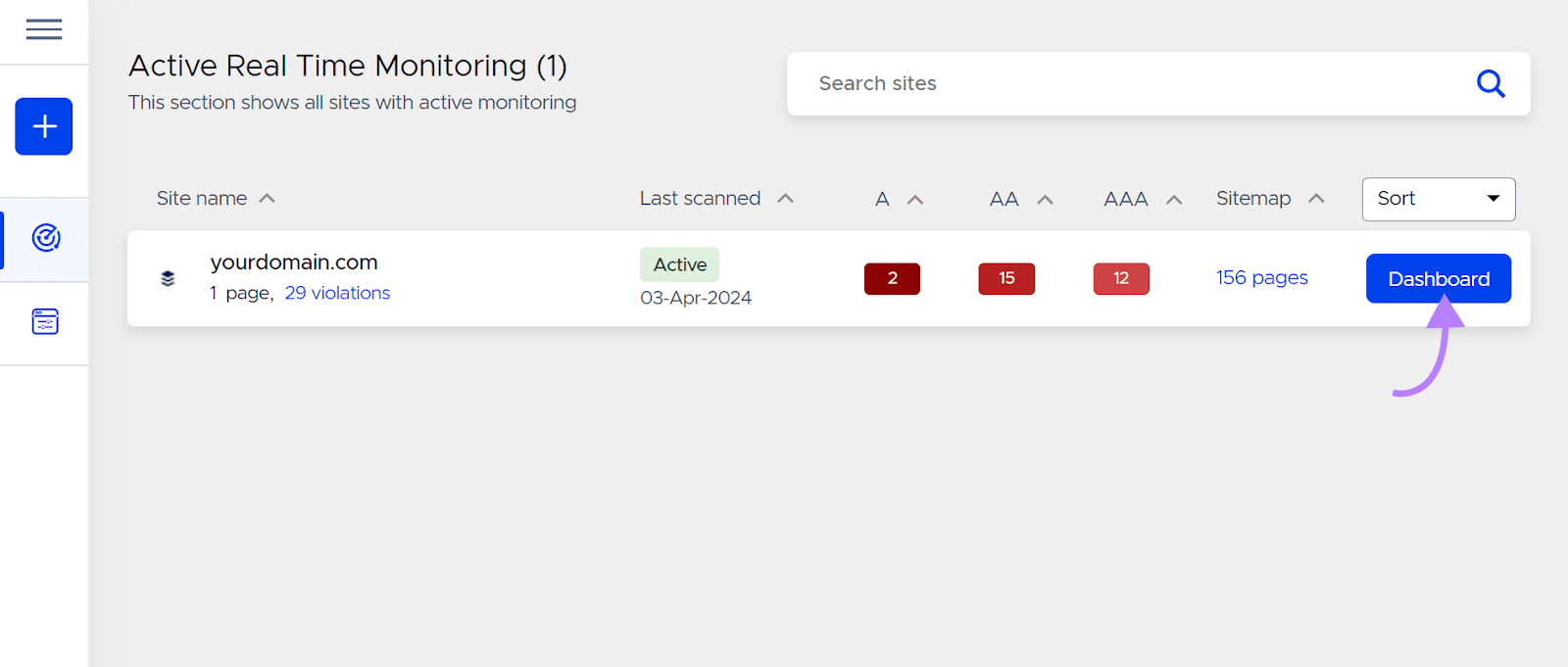
To be taught extra in regards to the violations, click on the “View # Violations” button.
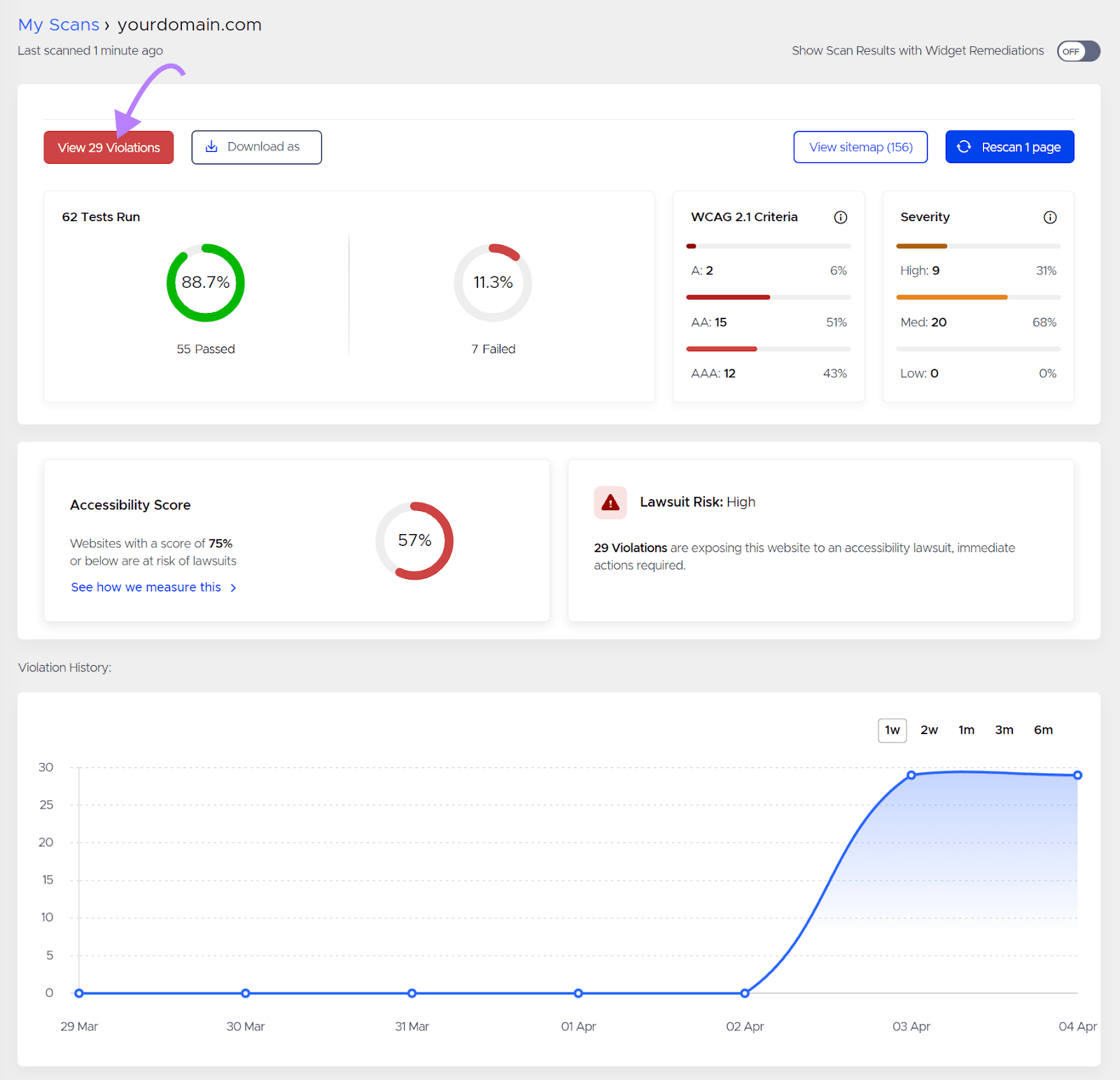
Develop a difficulty by clicking the “+” icon.
You may discover a description of the violation, advisable motion, and the affected code.
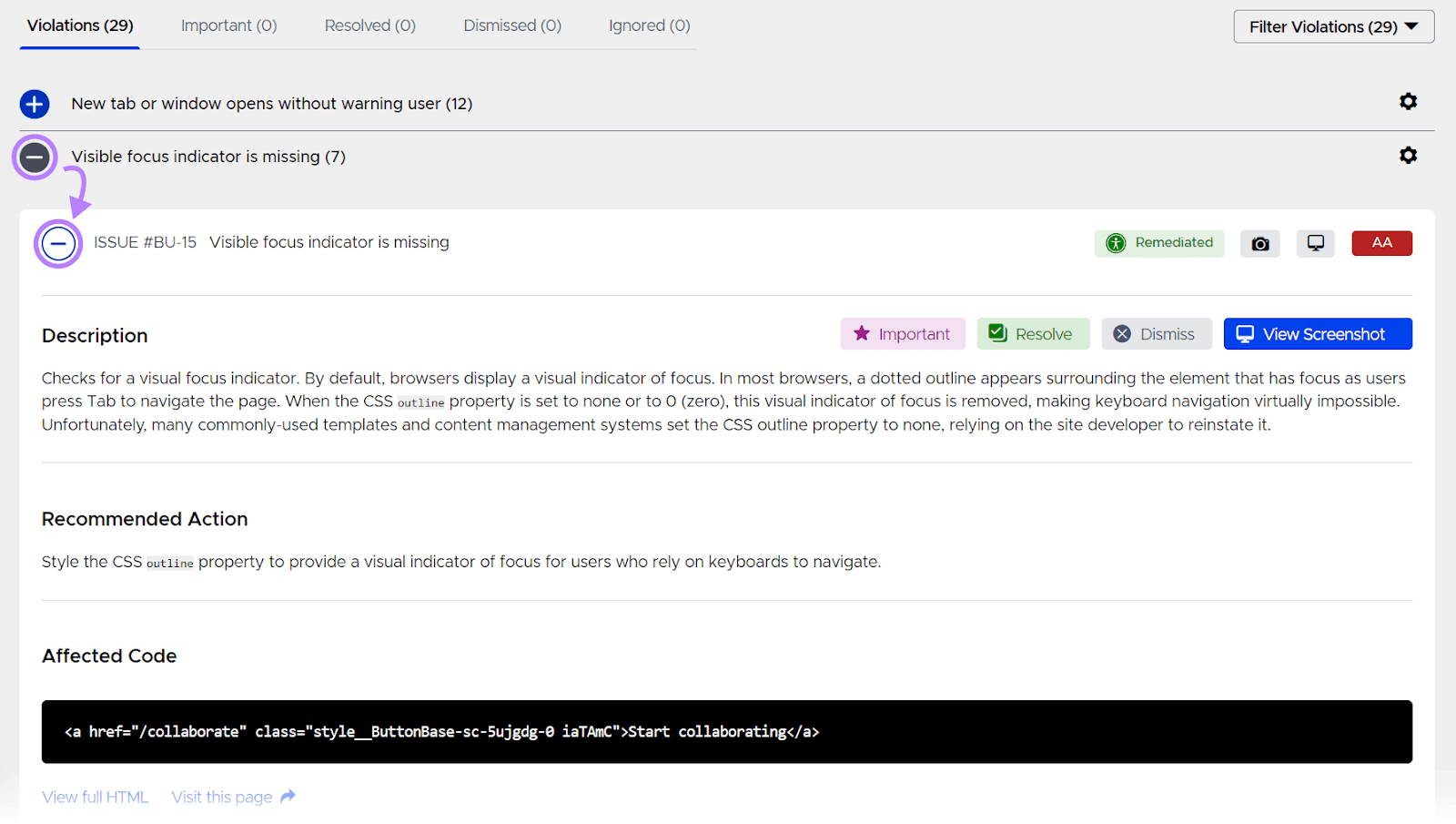
Many of those modifications shall be related to those that work on content material at your organization, so it’s finest to share these points with them. And you’ll work by means of them collectively.
Enhance Your Web site’s search engine optimisation
Serving to your organization obtain its targets relies upon partly on succeeding with search engine optimisation. For builders, which means making certain a robust technical basis that is primed for search engines like google and yahoo.
Get began with Semrush’s Site Audit instrument.
Audit your web site, establish technical search engine optimisation points, and repair them.
You possibly can even strive it without cost.




